Arcam AV860 User Manual [ru]
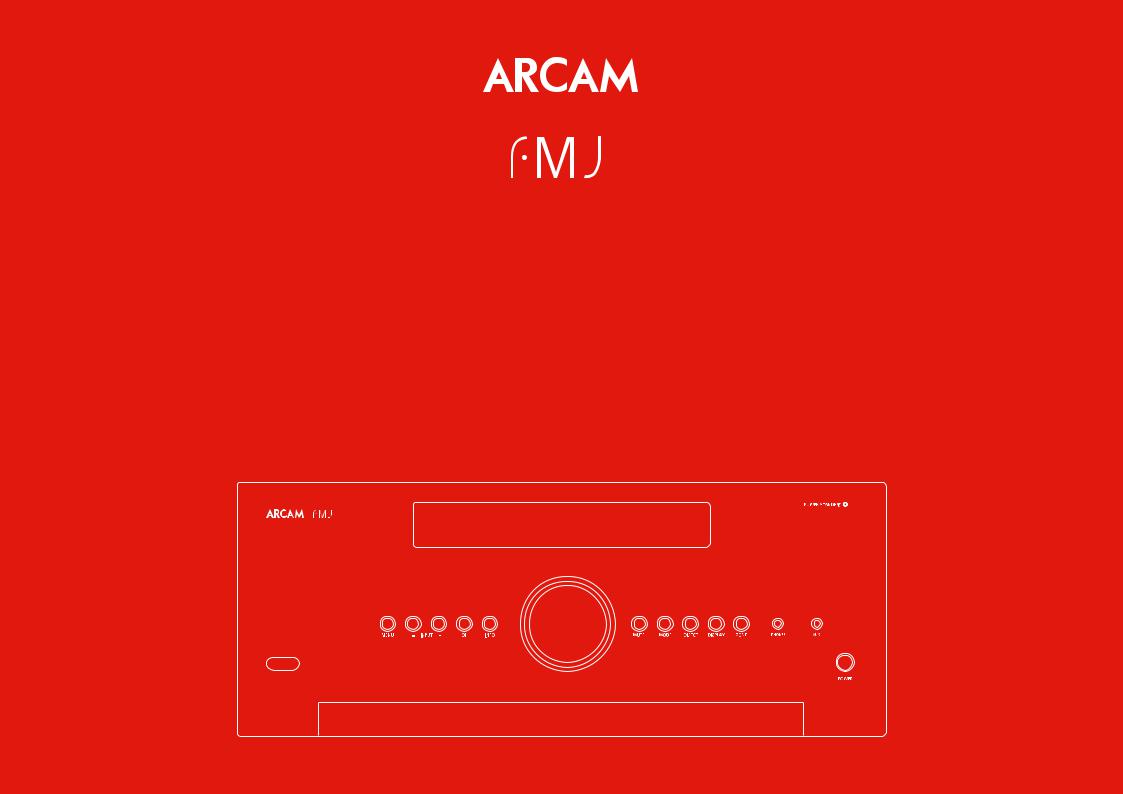
AV860/AVR850/AVR550/AVR390/SR250
HANDBOOK AVR surround amplifiers MANUEL Amplificateur surround AVR HANDBUCH AVR Surround Verstärker HANDLEIDING AVR surroundversterker MANUAL AVR amplificadores surround РУКОВОДСТВО AVR объемного усилители MANUALE Amplificatori Surround AVR
AVR
AVR850
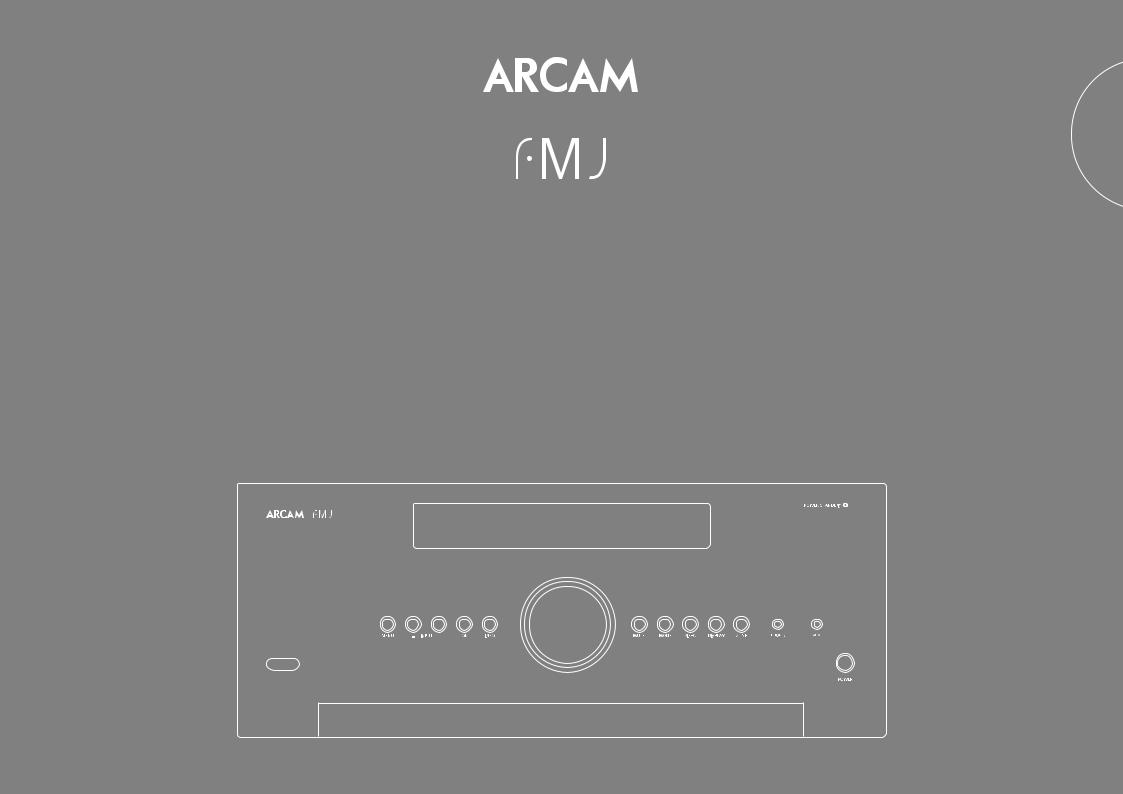
English
AV860/AVR850/AVR550/AVR390/SR250
HANDBOOK AVR surround amplifiers
AVR850
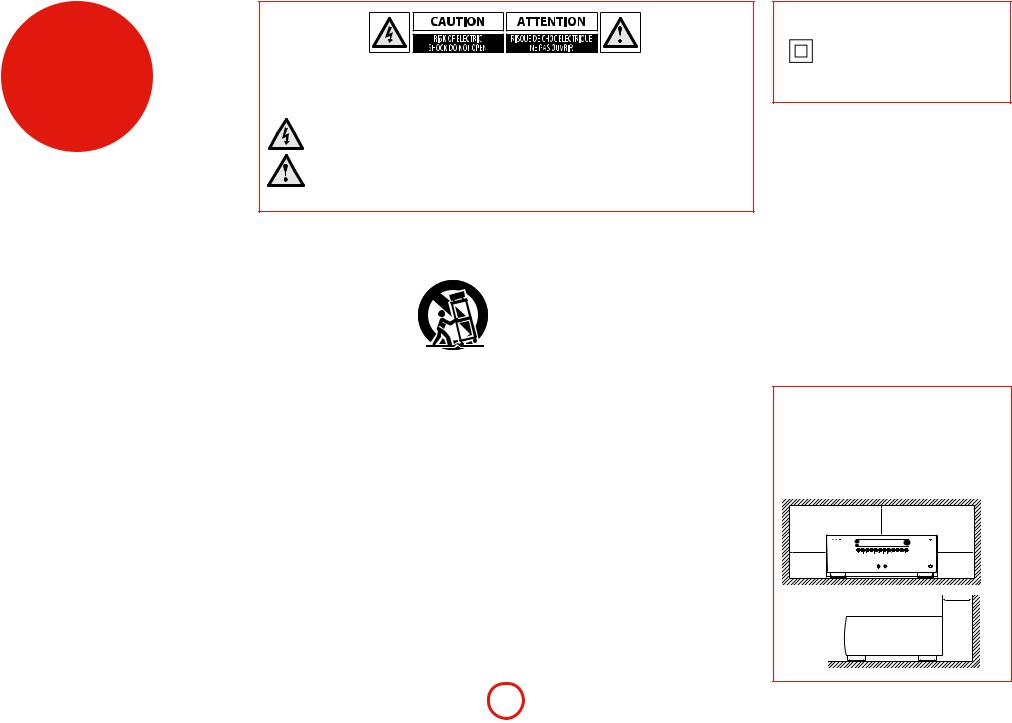
safety
CAUTION: To reduce the risk of electric shock, do not remove cover (or back). No user serviceable parts inside. Refer servicing to qualified service personnel.
WARNING: To reduce the risk of fire or electric shock, do not expose this apparatus to rain or moisture.
The lightning flash with an arrowhead symbol, within an equilateral triangle, is intended to alert the user to the presence of uninsulated ‘dangerous voltage’ within the product’s enclosure that may be of sufficient magnitude to constitute a risk of electric shock to persons.
The exclamation point within an equilateral triangle is intended to alert the user to the presence of important operating and maintenance (servicing) instructions in the literature accompanying the appliance.
CAUTION: In Canada and the USA, to prevent electric shock, match the wide blade of the plug to the wide slot in the socket and insert the plug fully into the socket.
Class II product
This equipment is a Class II or double insulated electrical appliance. It has been designed in such a way that it does not require a safety connection to electrical earth (‘ground’ in the U.S.).
Important safety instructions
1.Read these instructions.
2.Keep these instructions.
3.Heed all warnings.
4.Follow all instructions.
5.Do not use this apparatus near water.
6.Clean only with a dry cloth.
Unplug the unit from the mains supply before cleaning.
The case should normally only require a wipe with a soft, lint-free cloth. Do not use chemical solvents for cleaning.
We do not advise the use of furniture cleaning sprays or polishes as they can cause permanent white marks.
7. Do not block any of the ventilation openings.
Install in accordance with the manufacturer’s instructions.
8.Do not install near any heat sources such as radiators, heat registers, stoves, or other apparatus (including amplifiers) that produce heat.
9.Do not defeat the safety purpose of the polarized or grounding type plug.
A polarized plug has two blades with one wider than the other. A grounding type plug has two blades and a third grounding prong. The wide blade or the third prong
is provided for your safety. When the provided plug does not fit into your outlet, consult an electrician for replacement of the obsolete outlet.
10. Protect the power cord from being walked on or pinched particularly at plugs, convenient receptacles, and the point where they exit from the apparatus.
11.Only use the attachments/accessories specified by the manufacturer.
12.Use only with a cart, stand, tripod, bracket, or table specified by the manufacturer,
or sold with the apparatus.
When a cart is used, use caution when moving the cart/apparatus combination to avoid injury from tip-over.
13.Unplug this apparatus during lightning storms or when unused for long periods of time.
14.Refer all servicing to qualified service personnel.
Servicing is required when the apparatus has been damaged in any way, such as power supply cord or plug is damaged, liquid has been spilled or objects have fallen into the apparatus, the apparatus has been exposed to rain or moisture, does not operate normally, or has been dropped.
15. Object or liquid entry
WARNING – Take care that objects do not fall and liquids are not spilled into the enclosure through any openings. The equipment shall not be exposed to dripping or splashing. Liquid-filled objects such as vases should not be placed on the equipment.
16. Service Instructions
CAUTION – These servicing instructions are for use by qualified service personnel only. To reduce the risk of electric shock, do not perform any servicing other than
that contained in the operating instructions unless you are qualified to do so.
17. Climate
The equipment has been designed for use in moderate climates and in domestic situations. Unplug this equipment during lightning storms to prevent possible damage from a strike or mains surge.
18. Power sources
Only connect the equipment to a power supply of the type described in the operating instructions or as marked on the equipment.
The primary method of isolating the equipment from the mains supply is to remove the mains plug. The equipment must be installed in a manner that makes disconnection possible.
19. Power-cord protection
Power supply cords should be routed so that they are not likely to be walked on or pinched by items placed upon or against them. Pay particular attention to the point where they exit from the equipment.
20. Power lines
Locate any outdoor antenna/aerial away from power lines.
21. Speaker connections
Any speakers must be connected to the Receiver using class II wire (i.e. no connection to Earth should be made). Failure to observe this precaution may cause the unit to become damaged.
22. Non-use periods
If the equipment is not being used for an extended period, we recommend that you unplug the power cord of the equipment from the outlet, to save power.
23. Abnormal smell
If an abnormal smell or smoke is detected from the equipment, turn the power off immediately and unplug the equipment from the wall outlet. Contact your dealer and do not reconnect the equipment.
CAUTIONS ON INSTALLATION
For proper heat dispersal, do not install this unit in a confined space, such as a bookcase or similar enclosure.
•More than 0.3 m (12 in.) is recommended.
•Do not place any other equipment on this unit.
z
z |
z |
z
Wall
E-2
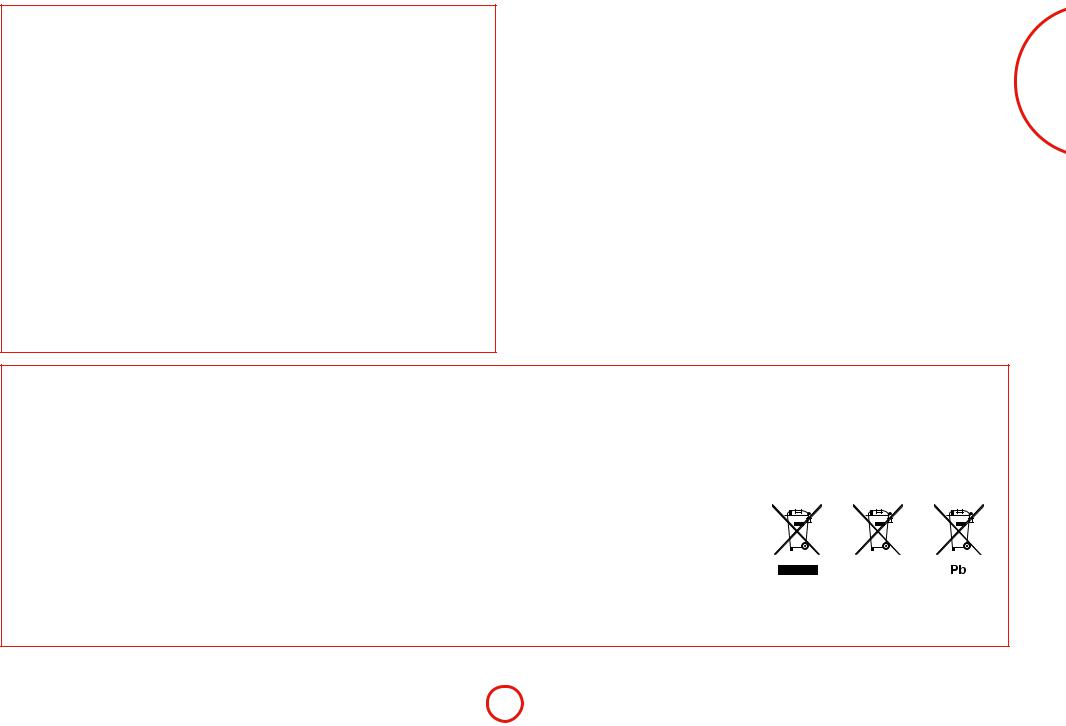
FCC INFORMATION (FOR US CUSTOMERS) 1. PRODUCT
This product complies with Part 15 of the FCC Rules. Operation is subject to the following two conditions:
(1) This device may not cause harmful interference, and (2) this device must accept any interference received, including interference that may cause undesired operation.
2. IMPORTANT NOTICE:
DO NOT MODIFY THIS PRODUCT
This product, when installed as indicated in the instructions contained in this manual, meets FCC requirements. Modification not expressly approved by ARCAM may void your authority, granted by the FCC, to use the product.
3. NOTE
This product has been tested and found to comply with the limits for a Class B digital device, persuant to Part 15 of the FCC Rules. These limits are designed to provide reasonable protection against harmful interference in a residential installation.
This product generates, uses and can radiate radio frequency energy and, if not installed and used in accordance with the instructions, may cause harmful interference to radio communications. However, there is no guarantee that interference will not occur in a particular installation. If this product does cause harmful interference to radio or television reception, which can be determined by turning the product OFF and ON, the user is encouraged to try to correct the interference by one or more of the following measures:
•Reorient or relocate the receiving antenna.
•Increase the separation between the equipment and receiver.
•Connect the product into an outlet on a circuit different from that to which the receiver is connected.
•Consult the local retailer authorized to distribute this type of product or an experienced radio/TV technician for help.
SAFETY INFORMATION
(FOR EUROPEAN CUSTOMERS)
•Avoid high temperatures. Allow for sufficient heat dispersion when installed in a rack.
•Handle the power cord carefully. Hold the plug when unplugging the cord.
•Keep the unit free from moisture, water, and dust.
•Unplug the power cord when not using the unit for long periods of time.
•Do not obstruct the ventilation holes.
•Do not let foreign objects into the unit.
•Do not let insecticides, benzene, and thinner come in contact with the unit.
•Never disassemble or modify the unit in any way.
•Ventilation should not be impeded by covering the ventilation openings with items, such as newspapers, tablecloths or curtains.
•Naked flame sources such as lighted candles should not be placed on the unit.
•Observe and follow local regulations regarding battery disposal.
•Do not expose the unit to dripping or splashing fluids.
•Do not place objects filled with liquids, such as vases, on the unit.
•Do not handle the mains cord with wet hands.
•When the switch is in the OFF position, the equipment is not completely switched off from MAINS.
•The equipment shall be installed near the power supply so that the power supply is easily accessible.
A NOTE ABOUT RECYCLING:
This product’s packaging materials are recyclable and can be reused. Please dispose of any materials in accordance with the local recycling regulations.When discarding the unit, comply with local rules or regulations.
Batteries should never be thrown away or incinerated but disposed of in accordance with the local regulations concerning battery disposal.
This product and the supplied accessories, excluding the batteries, constitute the applicable product according to the WEEE directive.
CORRECT DISPOSAL OF THIS PRODUCT
These markings indicate that this product should not be disposed with other household waste throughout the EU.
To prevent possible harm to the environment or human health from uncontrolled waste disposal and to conserve
material resources, this product should be recycled responsibly.
To dispose of your product, please use your local return and collection systems or contact the retailer where the product was purchased.
English
E-3

E-4
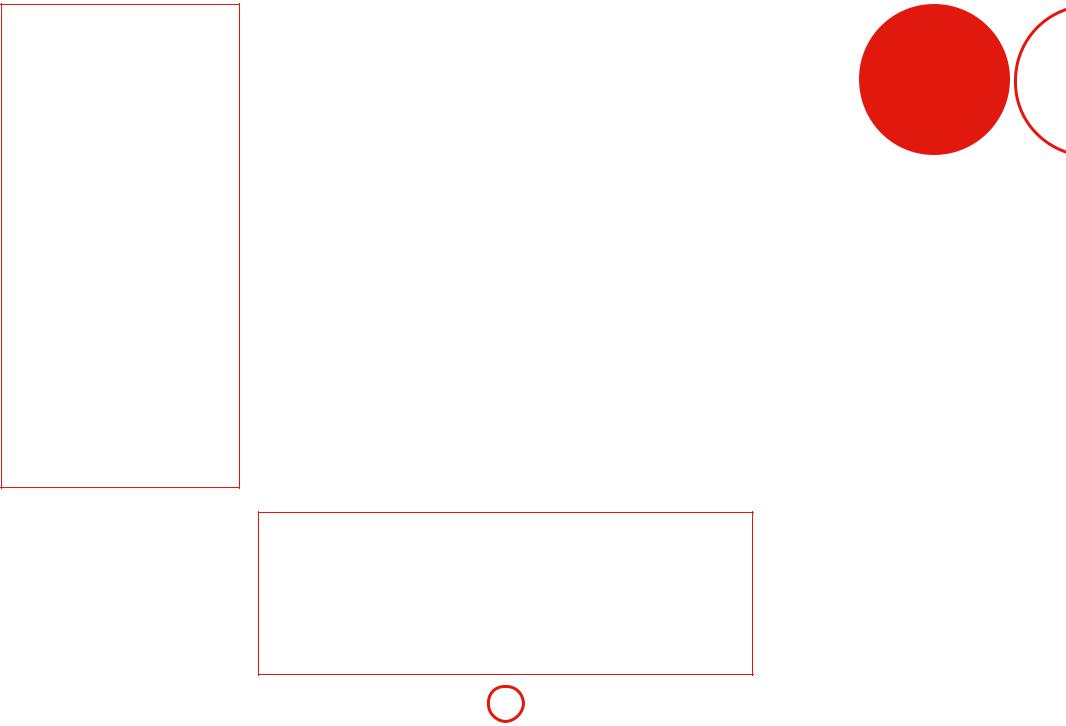
Contents
safety............................................................ |
E-2 |
welcome...................................................... |
E-5 |
before you begin…...................................E-6
rear panel connectors............................... |
E-9 |
audio/video connections...................... |
E-10 |
Connection guide................................................. |
E-12 |
radio connectors..................................... |
E-13 |
other connectors.................................... |
E-14 |
speakers................................................... |
E-15 |
operation.................................................. |
E-17 |
front panel operation............................ |
E-19 |
remote control........................................ |
E-20 |
essential setup........................................ |
E-26 |
auto speaker setup................................. |
E-27 |
setup menus............................................ |
E-28 |
decoding modes..................................... |
E-32 |
Dolby volume......................................................... |
E-34 |
Dolby atmos............................................................ |
E-34 |
tuner operation....................................... |
E-35 |
network/usb operation......................... |
E-36 |
multi-room set up................................... |
E-37 |
customising the remote........................ |
E-38 |
troubleshooting...................................... |
E-40 |
specifications........................................... |
E-42 |
legal information.................................... |
E-47 |
product guarantee................................. |
E-47 |
Thank you and congratulations on purchasing your Arcam FMJ Receiver.
Arcam has been producing specialist audio products of remarkable quality for over three decades and the new Receivers are the latest in a long line of award winning Hi-Fi. The design of the FMJ range draws upon all of Arcam’s experience as one of the UK’s most respected audio companies, to produce Arcam’s best performing range of products yet – designed and built to give you years of viewing and listening enjoyment.
This handbook is intended to give you a detailed guide to using the Receiver. It starts by giving advice on installation, moves on to describe how to use the product and finishes with additional information on the more advanced features. Use the contents list shown on this page to guide you to the section of interest.
We hope that your FMJ receiver will give you years of trouble-free operation. In the unlikely event of any fault, or if you simply require further information about Arcam products, our network of dealers will be happy to help you. Further information can also be found on the Arcam website at www.arcam.co.uk.
The FMJ development team
Professional Installation?
It may be that the Receiver has been installed and set up as part of your Hi-Fi installation by a qualified Arcam dealer. In this case, you may wish to skip the sections of this handbook dealing with installation and setting up, and move directly to the sections dealing with using the unit. Use the Contents list to guide you to these sections.
DIY setup?
The Receiver is a powerful and sophisticated piece of AV equipment. If you are setting the unit up yourself, it is recommended that you read this handbook thoroughly before beginning. For instance, correct speaker configuration and placement is a key to getting the most out of your Receiver and making sure that all the elements of your system work in harmony.
welcome
English
E-5
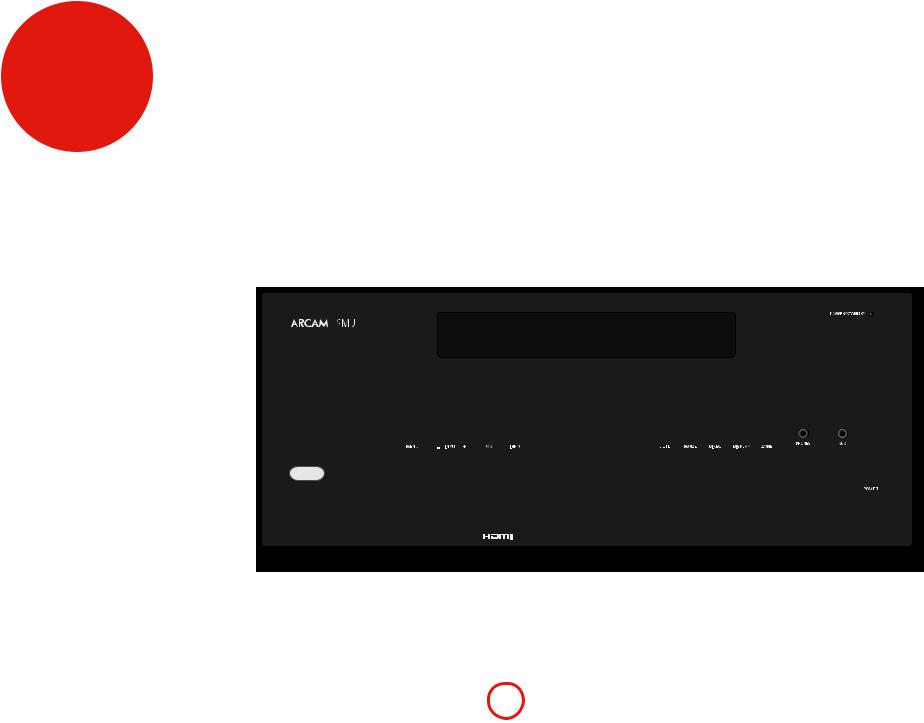
before you begin…
The Receivers are high-quality and high-performance home-cinema processors and amplifiers built to Arcam’s quality design and manufacturing standards. They combine digital processing with high-performance audio and video components to bring you an unrivalled home-entertainment centre.
The Receiver allows switching and control of seven analogue and six digital audio sources in addition to internal FM and DAB radios – as well as networked and USB audio sources – making any of the models an ideal hub for both home-cinema and two-channel stereo systems.
Since many of these source components are also capable of generating video signals, the Receiverincludes broadcast-quality switching for HDMI (6 x HDMI2.0a, HDCP2.2 & 1 x MHL) video/audio signals. Control of
the Receiver is either by front panel control buttons, IR remote control, IP (Ethernet) control or RS232 port.
The remote control supplied with the Receiver is a multi-device ‘universal’ learning remote control which is simple to use, and once set up is able to control a complete system. It can be programmed using its vast internal code library to control CD and BD players, PVRs, TVs and other devices.
The installation of the Receiver in a listening room is an important process which requires care at every stage. For this reason, the installation information is
very comprehensive and should be followed carefully to achieve an unrivalled level of performance.
The Receiver designed to produce a level of performance that will truly bring music and movies to life.
AVR850
E-6

Placing the unit
<<Place the unit on a level, firm surface, avoiding direct sunlight and sources of heat or damp.
<<Do not place the Receiver on top of a power amplifier or other source of heat.
<<Do not place the amplifier in an enclosed space such as a bookcase or closed cabinet unless there is good provision for ventilation. The Receiver will run warm during normal operation.
<<Do not place any other component or item on top of the amplifier as this may obstruct airflow around the heat-sink, causing the amplifier to run hot. (The unit placed on top of the amplifier would become hot, too.)
<<Make sure the remote-control receiver on the front panel display is unobstructed, otherwise this will impair the use of the remote-control. If line-of-sight is impractical, a remote-control repeater can be used with the rear panel connector (see page E-14).
<<Do not place your record deck on top of this unit. Record decks are very sensitive to the noise generated by mains power supplies which will be heard as a background ‘hum’ if the record deck is too close.
Power
The amplifier is supplied with a moulded mains plug already fitted to the lead. Check that the plug supplied fits your supply – should you require a new mains lead, please contact your Arcam dealer.
If your mains supply voltage or mains plug is different, please contact your Arcam dealer immediately.
The Receiver can be switched for operation between 220–240V (switch position 230V) and 110–120V (switch position 115V).
NOTE
Ensure that the Receiver is switched off and the power lead removed before changing the position of the voltage range switch.
Push the IEC plug end of the power cable into the socket on the back of the amplifier, making sure that it is pushed in firmly. Plug the other end of the cable into your mains socket and, if necessary, switch the socket on.
The Receiver can be turned on using the POWER switch on the front panel. While switched on, the front panel LED will glow green.
Standby power
The Receiver can be switched into standby mode using the 2 button on the remote control. While in standby mode the front panel LED will glow red and power consumption is less than 0.5 Watts.
While in Standby mode, it may be possible to hear a slight residual hum coming from the mains transformer inside the amplifier. This is perfectly normal. However, if the unit is to be left unused for an extended period, we recommend that you disconnect it from the mains supply to save power.
Interconnect cables
We recommend the use of high-quality screened cables that are designed for the particular application. Other cables will have different impedance characteristics that will degrade the performance of your system (for example, do not use cabling intended for video use to
carry audio signals). All cables should be kept as short as is practically possible.
It is good practice when connecting your equipment to make sure that the mains power-supply cabling is kept as far away as possible from your audio cables. Failure to do so may result in unwanted noise in the audio signals.
For information on speaker cabling, please refer to the ‘Speakers’ section, beginning on page E-15.
Radio interference
The Receiver is an audio device containing microprocessors and other digital electronics. Each model has been designed to very high standards of electromagnetic compatibility.
This is a Class A product. In a domestic environment this product may cause radio interference, in which case the user may be required to take adequate measures.
If the Receiver causes interference to radio or television reception (which can be determined by switching the Receiver off and on), the following measures should be taken:
<<Re-orient the receiving antenna or route the antenna cable of the affected receiver as far as possible from Receiver and its cabling.
<<Relocate the receiver with respect to the Receiver.
<<Connect the affected device and the Receiver to different mains outlets.
If the problem persists, please contact your Arcam dealer.
English
E-7
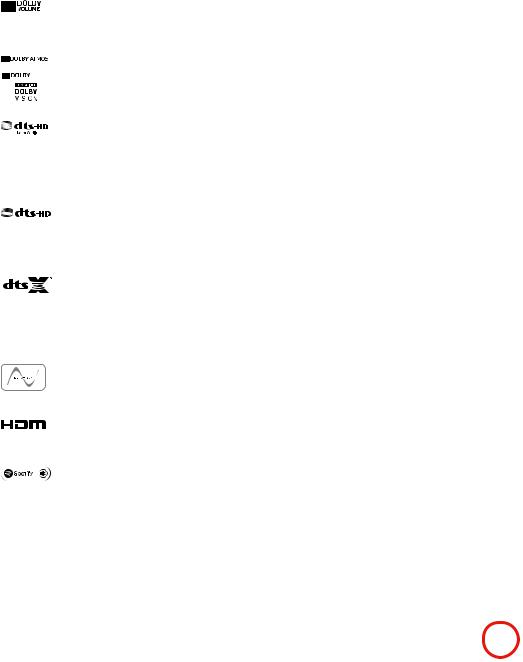
Trademark acknowledgements
Arcam is a registered trademark of A & R Cambridge Ltd.
|
|
|
|
|
Dolby Volume |
|
FLAC |
FLAC Decoder Copyright © 2000, 2001, 2002, |
|
|
|
|
|
Manufactured under license from Dolby |
|
|
2003, 2004, 2005, 2006, 2007, 2008 Josh Coalson |
|
|
|
|
|
|
|
|
|
|
|
|
|
|
Laboratories. Dolby and the double-D symbol |
|
|
Redistribution and use in source and binary |
|
|
|
|
|
are trademarks of Dolby Laboratories. |
|
|
|
|
|
|
|
|
|
|
forms, with or without modification, are |
|
|
|
|
|
|
|
|
|
|
|
|
|
|
|
Dolby Vision, Dolby Atmos, Dolby |
|
|
permitted provided that the following conditions |
|
|
AUDIO™ |
Audio |
|
|
are met: |
||
|
|
Manufactured under license from Dolby |
|
|
- Redistributions of source code must retain the |
|||
|
|
|
|
|
|
|
||
|
|
|
|
|
Laboratories. Dolby, Dolby Vision, Dolby Atmos, |
|
|
above copyright notice, this list of conditions |
|
|
|
|
|
Dolby Audio, and the double-D symbol are |
|
|
and the following disclaimer. |
|
|
|
|
|
|
|
||
|
|
|
|
|
registered trademarks of Dolby Laboratories. |
|
|
|
|
|
|
|
|
|
|
|
|
|
|
|
|
|
DTS-HD Master Audio™ |
|
|
- Redistributions in binary form must |
|
|
|
|
|
For DTS patents, see http://patents.dts.com. |
|
|
reproduce the above copyright notice, this list of |
|
|
|
|
|
|
|
conditions and the following disclaimer in the |
|
|
|
|
|
|
Manufactured under license from DTS Licensing |
|
|
documentation and/or other materials provided |
|
|
|
|
|
Limited. DTS, the Symbol, & DTS together in |
|
|
with the distribution. |
|
|
|
|
|
combination with the Symbol are trademarks of |
|
|
|
|
|
|
|
|
|
|
|
|
|
|
|
|
|
DTS, Inc. DTS and DTS-HD Master Audio are |
|
|
- Neither the name of the Xiph.org Foundation |
|
|
|
|
|
registered trademarks of DTS, Inc © DTS, Inc. |
|
|
|
|
|
|
|
|
|
|
nor the names of its contributors may be used |
|
|
|
|
|
|
All Rights Reserved. |
|
|
|
|
|
|
|
|
|
|
to endorse or promote products derived from |
|
|
|
|
|
|
|
|
|
|
|
|
|
|
|
DTS-HD™ |
|
|
|
|
|
|
|
|
|
|
this software without specific prior written |
|
|
|
|
|
|
For DTS patents, see http://patents.dts.com. |
|
|
permission. |
|
|
|
|
|
|
|
|
|
|
|
|
|
|
Manufactured under license from DTS Licensing |
|
|
THIS SOFTWARE IS PROVIDED BY |
|
|
|
|
|
Limited. DTS, DTS-HD, the Symbol, & DTS and |
|
|
|
|
|
|
|
|
|
|
THE COPYRIGHT HOLDERS AND |
|
|
|
|
|
|
the Symbol together are registered trademarks of |
|
|
|
|
|
|
|
|
|
|
CONTRIBUTORS ‘AS IS’ AND ANY EXPRESS |
|
|
|
|
|
|
DTS, Inc. © DTS, Inc. All Rights Reserved. |
|
|
|
|
|
|
|
|
|
|
|
OR IMPLIED WARRANTIES, INCLUDING, |
|
|
|
|
|
DTS:X™ |
|
|
|
|
|
|
|
|
|
|
BUT NOT LIMITED TO, THE IMPLIED |
|
|
|
|
|
|
For DTS patents, see http://patents.dts.com. |
|
|
WARRANTIES OF MERCHANTABILITY AND |
|
|
|
|
|
|
|
FITNESS FOR A PARTICULAR PURPOSE |
|
|
|
|
|
|
Manufactured under license from DTS Licensing |
|
|
|
|
|
|
|
|
|
|
ARE DISCLAIMED. IN NO EVENT SHALL |
|
|
|
|
|
|
Limited. DTS, the Symbol, DTS in combination |
|
|
|
|
|
|
|
|
|
|
THE FOUNDATION OR CONTRIBUTORS |
|
|
|
|
|
|
with the symbol, DTS:X and the DTS:X logo are |
|
|
|
|
|
|
|
|
registered trademarks or trademarks of DTS, Inc. |
|
|
BE LIABLE FOR ANY DIRECT, INDIRECT, |
|
|
|
|
|
in the United States and/or other countries. © |
|
|
INCIDENTAL, SPECIAL, EXEMPLARY, OR |
|
|
|
|
|
DTS, Inc. All Rights Reserved. |
|
|
CONSEQUENTIAL DAMAGES (INCLUDING, |
|
|
|
|
|
AAC/AAC Plus |
|
|
BUT NOT LIMITED TO, PROCUREMENT OF |
|
|
|
|
|
|
|
SUBSTITUTE GOODS OR SERVICES; LOSS |
|
|
|
|
|
|
|
|
|
|
|
|
|
|
|
aacPlus is a trademark of Coding Technologies. |
|
|
OF USE, DATA, OR PROFITS; OR BUSINESS |
|
|
|
|
|
See http://codtech.vhost.noris.net for more |
|
|
INTERRUPTION) HOWEVER CAUSED AND |
|
|
|
|
|
information. |
|
|
ON ANY THEORY OF LIABILITY, WHETHER |
|
|
|
|
|
|
|
|
IN CONTRACT, STRICT LIABILITY, OR |
|
|
|
|
|
HDMI, the HDMI logo and High-Definition |
|
|
|
|
|
|
|
|
|
|
TORT (INCLUDING NEGLIGENCE OR |
|
|
|
|
|
|
Multimedia Interface are trademarks or |
|
|
|
|
|
|
|
|
registered trademarks of HDMI Licensing LLC. |
|
|
OTHERWISE) ARISING IN ANY WAY OUT |
|
|
|
|
|
|
|
OF THE USE OF THIS SOFTWARE, EVEN IF |
|
|
|
|
|
|
|
|
|
|
|
|
|
|
|
|
|
|
ADVISED OF THE POSSIBILITY OF SUCH |
|
|
|
|
|
|
|
|
DAMAGE. |
|
|
|
|
|
Licenses: |
|
|
|
|
|
|
|
|
The Spotify software is subject to third party |
|
|
|
|
|
|
|
|
|
|
|
|
|
|
|
|
|
licenses found here: |
|
|
|
|
|
|
|
|
https://developer.spotify.com/esdk-third- |
|
|
|
|
|
|
|
|
party-licenses |
|
|
|
|
|
|
|
|
|
|
|
|
vTuner |
This product is protected by certain intellectual |
|
property rights of NEMS and BridgeCo. Use |
|
or distribution of such technology outside of |
|
this product is prohibited without a license |
|
from NEMS and BridgeCo or an authorized |
|
subsidiary. |
MP3 |
MPEG Layer-3 audio decoding technology |
|
licensed from Fraunhofer IIS and Thomson |
|
multimedia. |
|
|
E-8
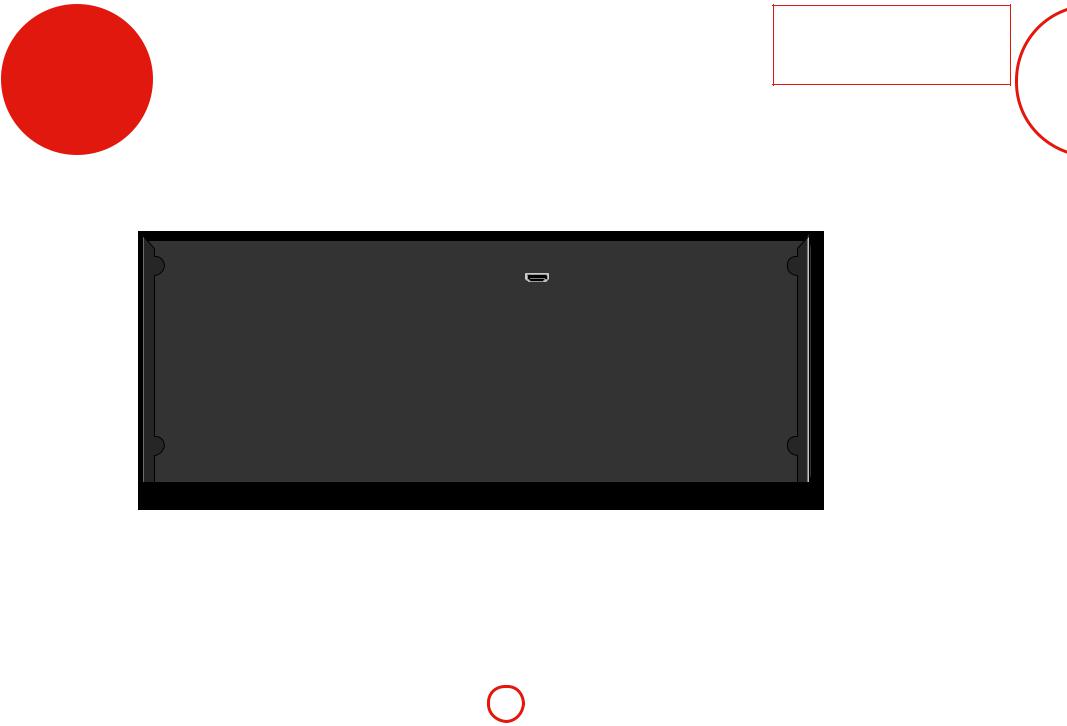
rear panel connectors
AVR850
AVR550
AVR390
Audio connectors
Analogue two-channel, see page E-11.
Preamplifier output
see page E-11.
SR250
NOTE
Please read the ‘Placing the unit’, ‘Power’ and ‘Interconnect cables’ sections on page E-7 before connecting up your Receiver!
HDMI connectors
For information, see page E-10.
Digital connectors |
|
FM/DAB |
Coaxial and optical digital audio |
FM aerial socket, or DAB |
|
connectors, see page E-11. |
aerial socket. |
|
STB/MHL |
GAME |
|
AV |
SAT |
BD |
|
VCR |
PVR |
ZONE2 |
OUTPUT2 |
OUTPUT1 |
|
|
|
|
|
||
|
|
|
|
|
|
|
|
|
|
OUT |
|
|
ARC |
|
|
|
|
|
|
|
|
|
HDMI |
|
|
|
DIGITAL AUDIO |
|
|
|
|
|
|
|
|
|
|
Z2 OUT |
STB |
GAME |
AV |
BD |
PVR CD |
SAT |
PVR |
|
|
|
|
|
|
|
|
|
|
|
|
|
|
|
|
|
|
|
|
|
|
FM/DAB |
|
|
TRIG Z1 |
Z1 IR |
|
|
|
|
|
|
|
|
|
|
|
|
|
|
|
|
|
|
|
|
|
|
|
|
|
|
|
|
|
|
|
ETHERNET |
|
|
|
|
|
|
|
|
|
|
|
|
|
|
|
|
|
|
|
USB 5V / 1A |
|
|
DC6V |
RS232 |
|
|
|
|
|
|
|
|
|
|
|
|
|
|
|
|
|
|
|
|
|
||
HEIGHT 1 |
HEIGHT 2 |
ANALOGUE AUDIO |
|
BD |
CD |
STB |
AV |
|
|
|
1.2A MAX |
TRIG Z2 |
Z2 IR |
|
|
|
||
|
|
|
|
COAXIAL |
OPTICAL |
|
|
|
|
|
|
Aerials, control and communication |
||||||
L |
|
|
|
|
|
|
|
|
|
|
|
|
|
|
|
|||
|
|
|
|
|
|
|
|
SPEAKER OUTPUTS |
|
|
|
|
|
|
Network, USB, FM/DAB aerial, voltage |
|
||
|
|
|
|
|
ZONE 2 R |
|
|
8Ω LOAD IMPEDANCE RECOMMENDED |
|
ZONE 2 L |
|
|
|
|
|
|||
R |
|
|
|
|
HEIGHT 1 R |
|
|
|
|
HEIGHT 1 L |
|
|
|
|
output, serial control, trigger and IR |
|
||
|
|
|
|
SBR |
SR |
FR |
C |
FL |
SL |
SBL |
|
|
|
|
|
|||
|
|
|
|
|
|
|
|
|
|
|||||||||
PREAMP OUT |
SUB 2 |
|
|
|
|
|
|
|
|
|
|
|
|
|
connectors, see page E-13, E-14. |
|
||
FL |
SL |
C |
SBL |
WIRING |
|
|
|
|
|
|
|
|
|
|
|
|
||
|
PREAMP OUT |
|
|
|
|
|
|
|
|
|
|
|
|
|
|
|
|
|
|
|
|
|
CLASS 2 |
|
|
|
|
|
|
|
~ 50 – 60 Hz 1.5KW MAX |
|
|
|
|
|
|
|
|
|
|
|
|
|
|
|
|
|
|
|
|
|
|
|
||
|
|
|
|
|
|
|
|
|
|
|
|
115 |
230 |
|
|
|
|
|
FR |
SR |
SUB |
SBR |
|
SBR |
SR |
FR |
C |
FL |
SL |
SBL |
|
|
|
|
|
|
|
|
HEIGHT 1 R |
|
|
|
|
|
HEIGHT1 L |
|
|
|
|
|
|
|
||||
|
|
|
|
|
ZONE 2 R |
|
|
|
|
|
ZONE 2 L |
|
|
|
|
|
|
|
|
|
|
|
|
|
|
Speaker connectors |
|
|
|
Power inlet |
|
|
|
|
|||
|
|
|
|
|
|
|
For information, see page E-16. |
|
|
Connect the correct mains cable here |
|
|
|
|||||
|
|
|
|
|
|
|
|
SPEAKER OUTPUTS |
|
|
|
|
|
AV860 |
SBR |
SR |
FR |
|
|
|
|
|
|
|
|
|
8Ω LOAD IMPEDANCE RECOMMENDED |
|
|
|
Voltage select |
|
|
|
|
||
|
|
|
|
|
|
|
R |
|
L |
|
|
|
|
|
|
|
||
|
|
|
|
|
|
|
|
|
|
|
Ensure the voltage selected |
|
|
|
||||
|
PREAMP OUT |
|
|
|
|
|
|
|
|
|
|
|
|
|
||||
|
|
|
|
|
|
|
|
|
|
|
|
|
|
|
|
|
||
L |
|
SUB2 |
|
|
|
|
|
|
|
|
|
|
matches your local power supply. |
|
|
|
||
|
|
|
|
|
|
|
|
|
|
|
|
|
|
|
|
|||
|
|
|
|
|
|
|
|
CLASS 2 WIRING |
|
|
|
|
|
|
|
|
|
|
R |
|
SUB1 |
|
|
|
|
|
|
|
|
|
|
|
|
|
|
|
|
E-9
English
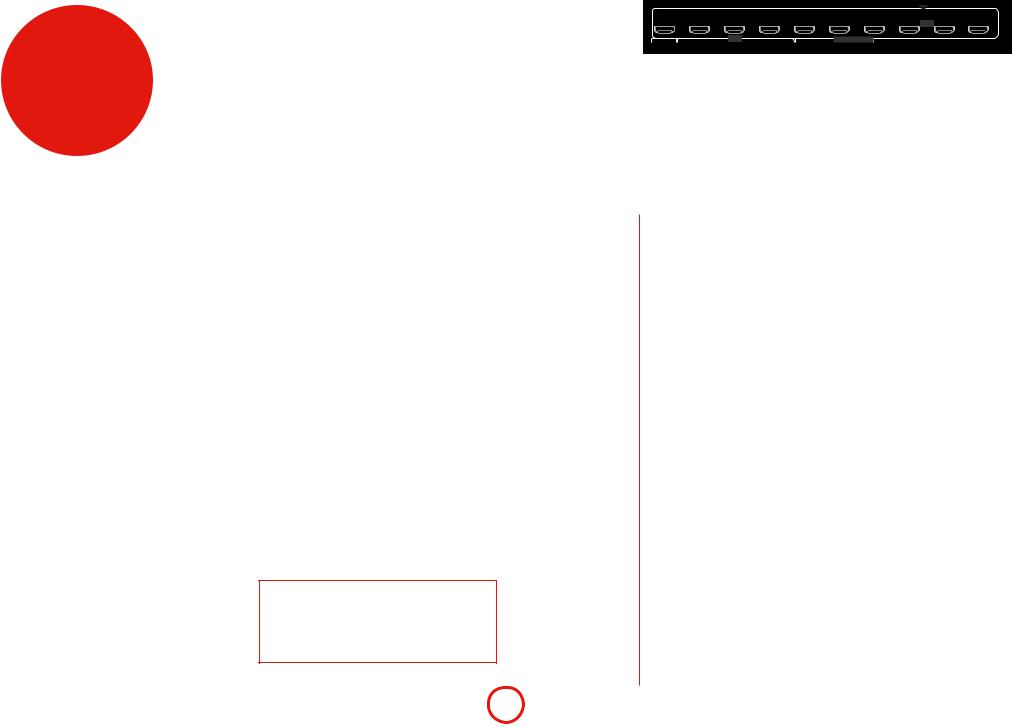
audio/video connections
Before connecting your Receiver to your source components and speakers, please read through the next few pages which will explain all the input and output connectivity that is available. The ‘Speakers’ section explains how to connect up your speakers to avoid damage to the amplifier and how to arrange your speakers for best performance.
General
The inputs are named to make it easier to reference connected devices (e.g. ‘BD’ or ‘VCR’). They all have the same input circuit, so there is no reason why you should not connect a different device to any of the inputs. For example, if you had two BD players and the AV input was not being used, then the second BD player could be connected to the AV input.
When connecting a video source, its audio must be connected to the corresponding sockets. For example, if you had a satellite decoder plugged into a SAT video input, the audio must be connected to the SAT audio inputs!
Making connections
<<Take care to place cables as far from any power supply cabling as is practicable, to reduce hum and other noise problems.
NOTE:
For each input, you must set the ‘Video Source’ and ‘Audio Source’ settings according to the connection type. (see “Input Config.” on page E-29)
STB/MHL |
GAME |
AV |
SAT |
BD |
VCR |
PVR |
ZONE2 |
OUTPUT2 |
OUTPUT1 |
|
|
|
|
|
|
|
OUT |
|
ARC |
|
|
HDMI |
|
|
DIGITAL AUDIO |
|
|
|
|
HDMI connectors
STB, GAME, AV, SAT, BD, VCR, PVR
Connect the HDMI video outputs of your source equipment to these corresponding HDMI inputs.
OUTPUT
Connect this output to the HDMI video input of your display device. This output is compatible with HDMI Audio Return Channel (ARC). If you have a supported television then sound from the television’s internal tuner (e.g. Freeview, Freesat, DVB-T) will be available using the Receiver’s ‘Display’ input.
E-10

Digital audio connectors
|
|
DIGITAL AUDIO |
|
SAT |
PVR |
|
|
BD |
CD |
STB |
AV |
COAXIAL |
OPTICAL |
||
SAT, PVR, BD, CD, STB, AV
Connect these inputs to the digital outputs of your available source equipment.
Zone 2 connectors
Z2 OUT
ZONE2
OUT
HEIGHT 1 H
The Z2 out HDMI connector can be used to connect the output of the Receiver to an system located in a second room.
Analogue preamplifier outputs
|
PREAMP OUT |
|
|
FL |
SL |
C |
SBL |
FR |
SR |
SUB |
SBR |
All preamplifier analogue outputs are buffered, have a low output impedance, are at line level and follow the Zone 1 volume control setting. They are able to drive long cables or several inputs in parallel if required.
For more information on connecting speakers or additional power amplifiers, see page E-15 and E-16.
The AV860 has XLR outputs in addition to the phono pre-outs for connection to an external amplifier.
Analogue audio inputs
HDMI
STB |
GAME |
AV |
BD |
PVR |
CD |
ANALOGUE AUDIO
1 HEIGHT 2
STB, GAME, AV, BD, PVR, CD
Connect the left and right inputs to the left and right outputs of your source equipment.
Front panel AUX input
The front panel AUX input can be used as an analogue input, using a stereo 3.5mm lead.
Front panel PHONES socket
This socket accepts headphones with an impedance rating between 32Ω and 600Ω, fitted with a 3.5mm stereo jack plug. The headphone socket is always active, except when Receiver is muted.
When the headphone jack is inserted, the speaker outputs and analogue preamplifier outputs are automatically muted.
English
E-11
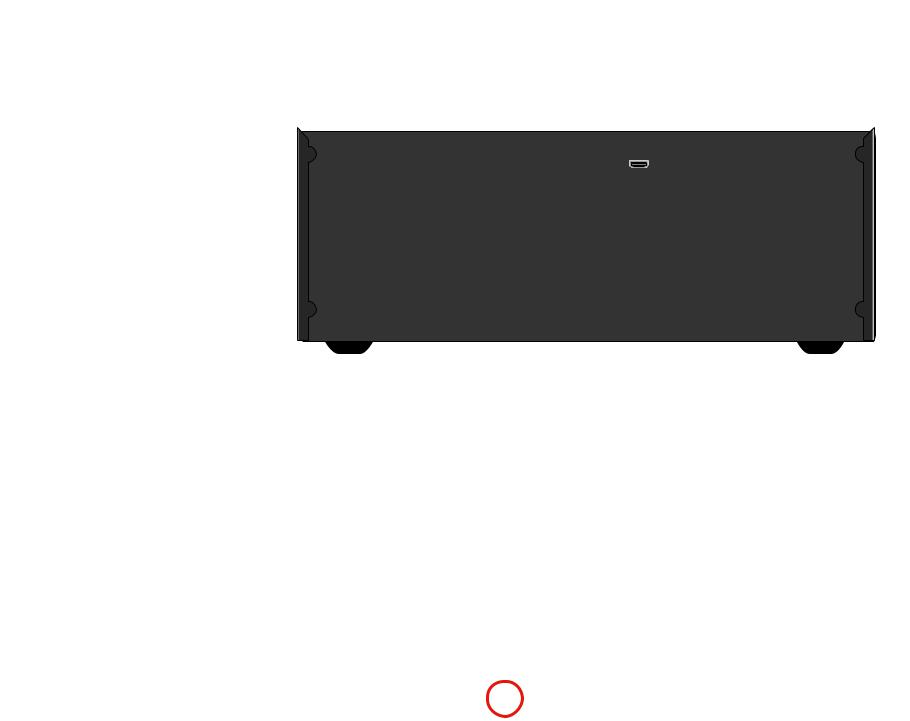
Connection guide
Blu-ray Disc (BD)/DVD player
The diagram shows how to make audio and video connections from a typical BD/DVD player.
The preferred audio hook-up is using the HDMI or coaxial digital connector (usually marked
DIGITAL AUDIO OUT), in addition to the coaxial analogue outputs for left and right channels.
In each case, use the audio inputs labelled BD on the Receiver.
Satellite receiver
A satellite receiver is connected in the same way as a BD player, with the same order of preference according to the outputs provided by the satellite receiver.
In each case, use the inputs labelled SAT on the Receiver. Note that digital audio input from a satellite receiver sometimes requires a coaxial/TOSLINK (digital connector) interconnect cable, as some satellite receivers do not implement audio over HDMI properly or at all.
CD player
Connect the digital audio output (if provided by the CD player) to the digital CD input of the Receiver, using a high quality coaxial interconnect cable.
Connect the right and left analogue audio outputs of the CD player to the analogue CD inputs of the Receiver, using a pair of high quality coaxial interconnect cables.
NOTE:
For each input, you must set the ‘Audio Source’ setting according to the connection type. (see “Input Config.” on page E-29)
BD/SAT
Pr Pb Y
E-12

DAB/FM
radio connectors
Aerial connectors
The Receiver is fitted with an FM and a DAB/DAB+ receiver module. The type of aerial you need depends on your listening preferences and the local conditions.
Your Receiver is capable of superb radio reception, but only if it is receiving a good quality transmission signal.
Try the aerials supplied with your unit. If you are in a medium to strong signal area, these should be adequate for good reception. In areas with poor signal strength, you may require a roof or loft mounted aerial.
Contact your local Arcam dealer or aerial installation experts for advice about local reception conditions.
FM/DAB
USB 5V / 1A
ZONE 2 L
In strong signal areas, the DAB/FM ‘T’ wire aerial supplied can be used with reasonable results. Mount the aerial as high up as possible on a wall.
In the UK the ‘T’ elements need to be positioned vertically for DAB reception since broadcasts are vertically polarised. In other localities, check with your Arcam dealer or try both horizontal and vertical positions for best reception.
Try each usable wall of the room to see which gives best reception and use tacks or adhesive tape to secure the aerial in a ‘T’ shape, but note
that no tacks should come into contact with the internal wire of the aerial.
When installed and receiving DAB/FM, check the signal strength by pressing the front panel or remote control’s INFO button until the signal quality indicator is displayed.
In weak signal areas, a high-gain, externallymounted or roof-mounted aerial is desirable in order to receive the highest number of services.
In Band III transmission areas (such as the UK), use a multi-element Yagi aerial with the elements mounted vertically, as the transmissions are vertically polarised. If you are close to more than one transmitter, use an omnidirectional or folded dipole aerial.
If the DAB services in your area are transmitted on L-band, then ask your dealer for advice for the best aerial to use.
English
E-13

other connectors
Serial connector
RS232 serial connector
RS232
The connector is used with control devices having an RS232 serial port (for example, Crestron and AMX touch-screen controllers).
Network connector
Networking is a large subject and only the briefest guidelines are presented in this handbook. Please contact your Arcam dealer or specialist installer for more information about introducing the Receiver into your computer network.
For information on how to use the Receiver’s network features, the USB socket, and for a list of supported file types, refer to see page E-36.
ETHERNET
USB 5V / 1A
Ethernet
If an Ethernet cable is connected, the Receiver will automatically attempt to connect to your network.
You should use CAT5 cable plugged into the RJ45 socket labelled ETHERNET on the rear panel.
If your network uses static IP addressing rather than DHCP, you will need to provide IP address, gateway and DNS; see page E-31 for information on setting up the network.
USB connector
The Receiver can play files stored on a USB mass storage device, typically a pen drive, but any USB device that complies with the ‘mass storage device‘ class is compatible.
The Receiver only supports the direct connection of USB devices and will not support devices connected through a hub. If regular access to the USB socket is required, you may find it convenient to use a USB extension lead; see page E-36 for details of supported file types.
Trigger connectors
TRIG Z1 |
tip: Trigger output |
sleeve: Ground
TRIG Z2
The trigger connectors (TRIG Z1 and TRIG Z2) provide an electrical signal whenever the Receiver is switched on and the relevant zone enabled.
The trigger signal can be used to switch on and off compatible pieces of home entertainment equipment, for example, you could set up a trigger to turn on your television and BD player whenever the Receiver was switched on.
There are two trigger output sockets on the Receiver, each capable of outputting a 12V, 70mA switching signal. The socket is designed for mono 3.5mm jacks: tip is the trigger output, sleeve is ground.
TRIG Z1
Use for remotely turning on and off power amps or source equipment for Zone 1. On = 12V, Off = 0V.
TRIG Z2
Use for remotely turning on and off power amps or source equipment for Zone 2. On = 12V, Off = 0V.
Infrared (IR) connectors
Z1 IR |
tip: Modulated signal |
sleeve: Ground
2 |
Z2 IR |
The infrared inputs (Z1 IR and Z2 IR) allow the connection of external IR receivers, either when the Receiver front panel IR receiver is fully or partially obstructed or to allow the use of a remote control in Zone 2.
There are two IR inputs on the Receiver, each designed for stereo or mono 3.5mm jacks. Tip is the modulated signal, sleeve is ground.
Z1 IR
This input is intended for use with a local IR receiver when the front panel of the Receiver is blocked.
Z2 IR
This input is intended for use with an IR receiver in Zone 2 to allow remote control of Receiver from a second room.
NOTE
Sockets referring to ‘Z2’ relate to connections used in multi-room installation. For more information on these connectors see page E-37.
A supplier of infra-red receivers and emitter accessories and systems is Xantech. See www.xantech.com for more information, or ask your Arcam dealer.
NOTE
The IR inputs on the Receiver are designed for modulated signals. If the external IR receiver demodulates the IR signal, it will not work. Also the unit does not provide power for external receivers on the IR jack, therefore an external power source will be required.
6V output
DC6V
1.2A MAX
This provides a 6V DC power connection for Arcam rSeries products.
E-14
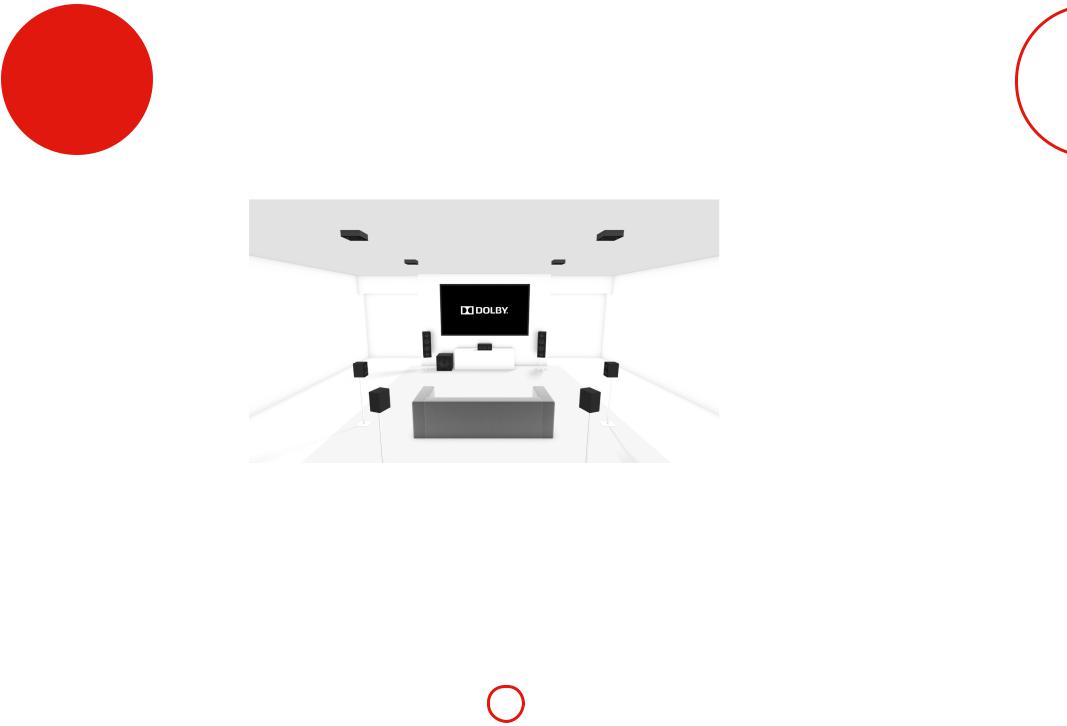
|
|
|
|
|
|
|
|
|
|
|
|
|
|
|
|
|
|
|
|
|
|
|
|
|
|
|
|
|
|
|
|
|
|
|
|
|
|
|
|
|
|
|
|
|
|
|
|
|
|
|
|
|
|
|
|
|
|
|
|
|
|
|
|
|
|
|
|
|
|
|
|
|
|
|
|
|
|
|
|
|
|
|
|
|
|
|
|
|
|
|
|
|
|
|
|
|
|
|
|
|
|
|
|
|
|
|
|
|
|
|
|
|
|
|
|
|
|
|
|
|
|
|
|
|
|
|
|
|
|
|
|
|
|
|
|
|
|
|
|
|
|
|
|
|
|
|
|
|
|
|
|
|
|
|
|
|
|
|
|
|
|
|
|
|
|
|
|
|
|
|
|
|
|
|
|
|
|
|
|
|
|
|
|
|
|
|
|
|
|
|
|
|
|
|
|
|
|
|
|
|
|
|
|
|
|
|
|
|
|
|
|
|
|
|
|
|
|
|
|
|
|
|
|
|
|
|
|
|
|
|
|
|
|
|
|
|
|
|
|
|
|
|
|
|
|
|
|
|
|
|
|
|
|
|
|
|
|
|
|
|
|
|
|
|
|
|
|
|
|
|
|
|
|
|
|
|
|
|
|
|
|
|
|
|
|
|
|
|
|
|
|
|
|
|
|
|
|
|
|
|
|
|
|
|
|
|
|
|
|
|
|
|
|
|
|
|
|
|
|
|
|
|
|
|
|
|
|
|
|
|
|
|
|
|
|
|
|
|
|
|
|
|
|
|
|
|
|
|
listener’s ears. Place the two surround |
||||||||||
|
|
|
the ambient sound and effects present in a |
|
|||||||||||||||||||
|
|
|
|
back speakers such that there is an arc of |
|||||||||||||||||||
|
|
|
multichannel home cinema system and should be |
||||||||||||||||||||
|
|
|
approximately 150 degrees between each |
||||||||||||||||||||
|
|
|
installed slightly higher than the listener’s ears. |
|
|||||||||||||||||||
|
|
|
|
surround back speaker and the centre speaker. |
|||||||||||||||||||
|
|
|
|
|
|
Subwoofer |
|
||||||||||||||||
|
|
|
|
|
|
|
The surround back speakers should face the front |
||||||||||||||||
|
|
|
|
|
|
|
of the room as shown in the diagram to provide |
||||||||||||||||
|
|
|
|
|
|
|
the largest ‘sweet spot’. |
||||||||||||||||
|
A subwoofer will greatly improve the bass performance of your |
|
|
|
|
|
|
|
|
|
|
|
|
||||||||||
|
system. This is useful for reproducing special cinema effects, |
|
|
|
|
|
|
|
|
|
|
|
|
||||||||||
speakers |
especially where a dedicated LFE (Low Frequency Effects) |
|
|
|
|
|
|
|
|
|
|
|
|
||||||||||
channel is available, as with many discs encoded with Dolby or |
|
|
|
|
|
|
|
|
|
|
|
|
|||||||||||
|
|
|
DTS technologies. |
|
Centre |
||||||||||||||||||
|
More than one subwoofer unit may be required for larger |
|
The centre speaker allows for a more realistic |
||||||||||||||||||||
|
installations, particularly in rooms of a timber frame |
|
reproduction of dialogue. The centre speaker |
||||||||||||||||||||
|
|
|
|
|
|
|
construction. |
|
should have a similar tonal balance to the front |
||||||||||||||
|
|
|
|
|
|
|
|
|
|
|
|
|
left and right speakers and be positioned at a |
||||||||||
|
|
|
|
|
|
|
|
|
|
|
|
|
similar height. |
||||||||||
The AV860/AVR850/AVR550/AVR390 allows you |
|
|
|
|
|
|
|
|
|
|
|
|
|
|
|
|
|
|
|
Height speakers |
|||
to connect up to seven speakers and up to two active |
|
|
|
|
|
|
|
|
|
|
|
|
|
|
|
|
|
|
|
With the AV860/AVR850/AVR550/AVR390 |
|||
subwoofers in the main system. The output channels |
|
|
|
|
|
|
|
|
|
|
|
|
|
|
|
|
|
|
|
||||
correspond to speakers installed in the front left, centre, |
|
|
|
|
|
|
|
|
|
|
|
|
|
|
|
|
|
|
|
up to four height speakers can be attached and |
|||
front right, surround left, surround right, surround back |
|
|
|
|
|
|
|
|
|
|
|
|
|
|
|
|
|
|
|
can be either mounted in the ceiling or ‘Dolby |
|||
left, surround back right, height 1 right, height 1 left |
|
|
|
|
|
|
|
|
|
|
|
|
|
|
|
|
|
|
|
enabled’ elevation speakers - see page E-34 for |
|||
and an active subwoofer. In addition, up to four height |
|
|
|
|
|
|
|
|
|
|
|
|
|
|
|
|
|
|
|
more information. |
|||
speakers can be attached using an additional power |
|
|
|
|
|
|
|
|
|
|
|
|
|
|
|
|
|
|
|
|
|
|
|
amplifier, see page E-16 for more information. |
|
|
|
|
|
|
|
|
|
|
|
|
|
|
|
|
|
|
|
|
|
|
|
|
|
|
|
|
|
|
|
|
|
|
|
|
|
|
|
|
|
|
|
|
Front left and right |
||
With the addition of correctly installed and configured |
|
|
|
|
|
|
|
|
|
|
|
|
|
|
|
|
|
|
|
Position your front left and right speakers to |
|||
height channels, Dolby Atmos for the home brings the |
|
|
|
|
|
|
|
|
|
|
|
|
|
|
|
|
|
|
|
achieve a good stereo image for normal musical |
|||
ultimate cinema sound experience to your home theatre |
|
|
|
|
|
|
|
|
|
|
|
|
|
|
|
|
|
|
|
reproduction as well as for the multichannel |
|||
to create powerful, moving audio that flows around you. |
|
|
|
|
|
|
|
|
|
|
|
|
|
|
|
|
|
|
|
modes. If they are placed too close together there |
|||
|
|
|
|
|
|
|
|
|
|
|
|
|
|
|
|
|
|
|
|
|
will be a lack of spaciousness; if they are placed |
||
The configuration and placement of your speakers is |
|
|
|
|
|
|
|
|
|
|
|
|
|
|
|
|
|
|
|
too far apart a stereo image will appear to have a |
|||
|
|
|
|
|
|
|
|
|
|
|
|
|
|
|
|
|
|
|
large ‘hole’ in the middle and will be presented in |
||||
very important. All speakers, with the exception of the |
|
|
|
|
|
|
|
|
|
|
|
|
|
|
|
|
|
|
|
two halves. |
|||
subwoofer(s), should be arranged around your normal |
|
|
|
|
|
|
|
|
|
|
|
|
|
|
|
|
|
|
|
|
|
|
|
viewing/listening position. The subwoofer should be |
|
|
|
|
|
|
|
|
|
|
|
|
|
|
|
|
|
|
|
|
|
|
|
placed in a position which gives an even frequency |
|
|
|
|
|
|
|
|
|
|
|
|
|
|
|
|
|
|
|
|
|
|
|
response in all listening positions. Incorrect placement |
|
|
|
|
|
|
|
|
|
|
|
|
|
|
|
|
|
|
|
|
|
|
|
leads to bass boom in some areas. Often the only way |
|
|
|
|
|
|
|
|
|
|
|
Surround back left and right |
|||||||||||
to find a good position for your subwoofer(s) is by |
|
|
|
|
|
|
|
|
|
|
|
||||||||||||
experimentation. A good place to start experimenting |
|
|
|
|
|
|
|
|
|
|
|
The surround back left and right speakers |
|||||||||||
is close to a wall but at least 1m away from any corners. |
|
|
|
|
|
|
|
|
|
|
|
are used to add extra depth and better |
|||||||||||
You can also consult your subwoofer handbook for |
|
Surround left and right |
|
sound localisation and should be installed |
|||||||||||||||||||
placement suggestions. |
|
|
The surround left and right speakers reproduce |
|
approximately one metre higher than the |
||||||||||||||||||
|
|
|
|
|
|
|
|
|
|
|
|
|
|
|
|||||||||
|
|
|
|
|
|
|
|
|
|
|
|
E-15 |
|||||||||||
English
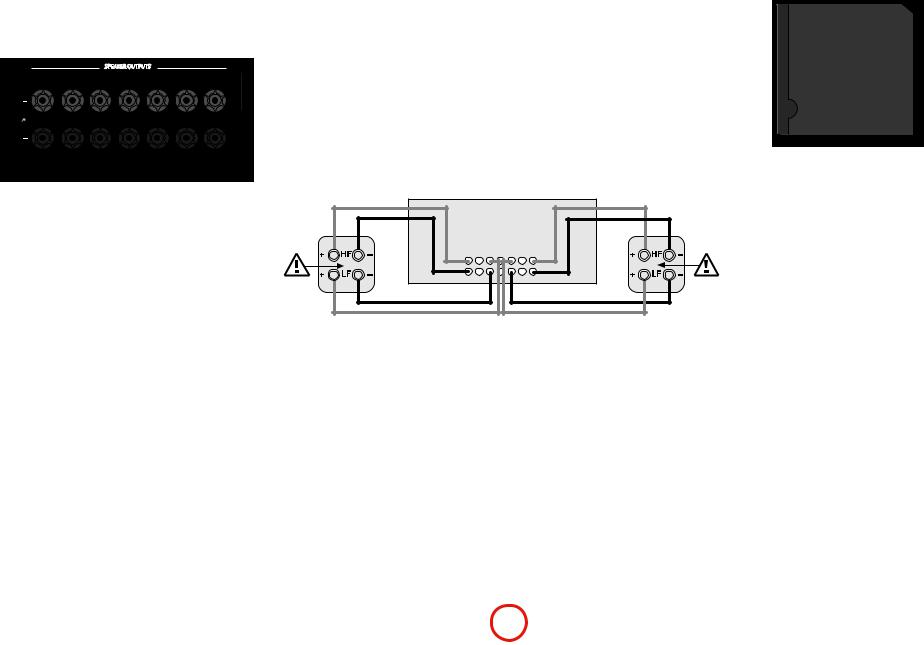
Connecting speakers
To connect each of the speakers, unscrew the corresponding terminals on the back of the Receiver, insert the speaker wires through the hole in each post and screw the terminals back up. Make sure that the red (positive/+) terminal of the speaker is connected to the red (positive/+) terminal on the back panel, and the black (negative/–) terminal of the speaker is connected to the black (negative/–) terminal on the back panel.
SPEAKER OUTPUTS
ZONE 2 R |
|
|
8Ω LOAD IMPEDANCE RECOMMENDED |
|
|
ZONE 2 L |
HEIGHT 1 R |
|
|
|
|
|
HEIGHT 1 L |
SBR |
SR |
FR |
C |
FL |
SL |
SBL |
CLASS 2 WIRING |
|
|
|
|
|
~ 5 |
|
|
|
|
|
|
|
|
|
|
|
|
|
1 |
SBR |
SR |
FR |
C |
FL |
SL |
SBL |
HEIGHT 1 R |
|
|
|
|
|
HEIGHT1 L |
ZONE 2 R |
|
|
|
|
|
ZONE 2 L |
It is important that no stray strands of wire from these connections are allowed to touch another cable or the product casing. Failure to ensure this can cause a short circuit and damage your Receiver.
Do not over-tighten the loudspeaker terminals, or use a wrench, pliers, etc., as this could damage the terminals and this would not be covered under the product’s warranty.
Speaker cables
The speakers should be connected to the amplifier using good-quality, high-purity, low impedance copper cables. Cheap speaker cables should be avoided – they are a false economy and can significantly degrade the sound quality.
The cable runs to the speakers should be as short as practicable. Connections to the speaker terminals should always be finger tight, whether using bare wires or spade connectors.
Bi-amping the Front Left & Front Right speakers
Bi-amping is the use of two amplifier channels per speaker. Bi-amping can provide better sound quality than conventional single wiring. If you do not have Surround Back speakers (i.e. you have a 5.1 surround system, not a 7.1 system) then you can use the spare Surround Back speaker outputs to bi-amplify the front left and right speakers, if your speakers support bi-amping. The spare channels can alternatively be used to power stereo speakers in another room (Zone 2).
Speakers that support bi-amping have two sets of +/- terminals per speaker, usually linked together by metal strips. These metal strips MUST be removed when bi-amping; failure to remove them will result in damage to the amplifier that is not covered under warranty.
To bi-amp the front left and right speakers, remove the metal strips from the speaker terminals. Connect the woofer or LF terminals to the FL and FR
terminals on the Receiver. Connect the tweeter or HF terminals to the SBL and SBR terminals on the Receiver. Finally, navigate to the Setup Menu ‘Spkr Types’ and set the ‘Use Channels 6+7 for’ menu option to ‘BiAmp L+R’; see page E-26.
Link MUST be removed
SBR FR FL SBL
Connecting subwoofers
|
PREAMP OUT |
|
|
|
|
ANA |
|
|
|
|
|
HEIGHT 1 |
HEIGHT 2 |
|
|
FL |
SL |
C |
SBL |
|
|
||
|
|
|
|
||||
|
|
|
|
L |
|
|
|
|
|
|
|
R |
|
|
|
FR |
SR |
SUB |
SBR |
PREAMP OUT |
SUB 2 |
|
|
|
|
|
|
||||
|
|
|
|
|
PREAMP OUT |
|
|
|
|
|
|
FL |
SL |
C |
S |
The Receiver also allows up to two active subwoofer to be connected to the SUB outputs. Refer to your subwoofer handbook for the correct setting up and connection procedure for your particular subwoofer(s).
Link MUST be removed
Using external power amplifiers
The internal power amplifier of the Receiver (SR250 L, R, Sub only) can be supplemented or replaced with external power amplification, such as the Arcam P49 (recommended gain 31dB). Connect the
sockets to your power amplifier inputs:
HEIGHT 1 |
HEIGHT 2 |
|
ANALOGUE AU |
|
|
||
L |
|
|
|
R |
|
|
|
PREAMP OUT |
SUB 2 |
|
|
|
PREAMP OUT |
|
|
FL |
SL |
C |
SBL |
FR |
SR |
SUB |
SBR |
FL, FR
Connect these to the equivalent Right and Left front channels of your power amplifier. For the SR250, only this and the sub outputs are available
C
Connect these to the Centre front channel of your power amplifier.
SUB
Subwoofer outputs. Connect this to the input of your active subwoofer(s), if present. For the SR250, only this and the FL, FLR outputs are available
SR, SL
Surround Right and Surround Left outputs. Connect these to the Surround Right and Left power amplifier inputs.
SBR, SBL
Surround Back Right and Surround Back Left outputs (only used in 7.1 channel systems). Connect these to the Surround Back Right and Surround Back Left power amplifier inputs.
Height 1, Height 2
Height 1 and Height 2. Connect these to the Height 1 and/or Height 2 power amplifier inputs.
All preamplifier analogue outputs are buffered, have a low output impedance and are at line level. They are able to drive long cables or several inputs in parallel if required.
E-16

operation
Operating your Receiver
For information display we recommend you use the OSD (On-Screen Display) on your display device whenever possible.
Switching on
Press the front panel power button in. The power LED will glow green, the front display shows the word
‘ARCAM’. When initialisation is complete, the display shows the volume setting and the name of the selected input.
Please wait until the unit has finished initialising before operating the Receiver. It is recommended that if the unit is switched off, you should wait at least 10 seconds before switching the unit back on.
Standby
The Receiver has a standby mode which can be entered by pressing STANDBY on the remote control. When in standby mode, the display is blank and the POWER LED glows red.
If the unit is to be left unused for an extended period, we recommend that you disconnect it from the mains supply to save power.
To switch on from standby
Press the STANDBY button on the remote control, any key on the front panel (other than the power button) or rotate the volume knob.
Front panel display
The Receiver is ready for use after about four seconds.
B D |
3 7 |
|
|
The display window shows the currently selected source and the last selected information view setting (this information line can be changed using the INFO button).
The current volume setting for Zone 1 (37.0dB in the above example) is displayed on the front panel. The volume setting for Zone 2 is displayed temporarily whenever it is adjusted.
Selecting a source
To select a particular source, press the –INPUT or INPUT+ buttons until that source is shown on the front panel display, or (if available) press the corresponding
source button on the remote. The following sources are available:
STB Set Top Box input
GAME Game console input
AV Audio-Visual input
SAT Satellite input
BD Blu-ray Disc/DVD player input
VCR Video Cassette Recorder input
PVR Personal Video Recorder input
CD Compact Disc player input
FM Internal tuner input
DAB Internal tuner input (this source is market dependent and may not be available on your Receiver)
NET Ethernet input
USB External USB solid-state device (e.g. pen drive) input
AUX Auxiliary (front panel) input
DISPLAY The Audio Return Channel (ARC) from a compliant display. Use this with a compliant television using internal TV tuners.
Most audio inputs have both analogue and digital connections. You must specify the type of connection used for each input using the ‘Audio Source’ option in the ‘Input Config.’ menu, see page E-29. Note that an incorrect setting will result in no sound — the default is HDMI audio. If you are not using HDMI audio then this setting must be changed.
The processing mode and Stereo Direct functions are remembered and recalled for each individual input.
Stereo Direct
To listen to a pure analogue stereo input, press the DIRECT button. The Stereo Direct mode automatically bypasses all processing and any surround functions. In direct mode, digital processing is shut down to improve the sound quality and reduces digital noise with the Receiver to an absolute minimum.
Note: when Stereo Direct mode is selected, no digital output is available and no bass management is performed, meaning that bass signals will not be redirected to a subwoofer.
Volume control
It is important to realise that the level of the volume indicator is not an accurate indication of the power delivered to your loudspeakers. The Receiver often delivers its full output power long before the volume control reaches its maximum position, particularly when listening to heavily recorded music. In comparison, some movie sound tracks can appear very quiet, as many directors like to keep maximum levels in reserve for special effects sequences.
Headphones
To use headphones with the Receiver, plug the headphones into the PHONES socket in the centre of the front panel.
When headphones are plugged into the front panel PHONES socket, the outputs for Zone 1 are muted and the audio will be down-mixed to two channels (2.0). The two-channel down-mix is required so that the centre channel and surround information can be heard via the headphones.
English
E-17

Using Zone 2
Zone 2 provides the option for the occupants of the master bedroom, conservatory, kitchen, etc. to view or listen to a different source at a different volume level from the main zone (Zone 1).
Source selection and volume control for Zone 2 is achieved:
<<by using an IR receiver in Zone 2 (see “Zone 2 control connections” on page E-37), or
<<by switching over to Zone 2 control by pressing the front panel zone button, or
<<by pressing AMP + OK on the remote control.
The front panel VFD display indicates that control has been switched to Zone 2.
S T A N D B Y |
Z 2 |
5 0 |
|
|
|
To turn on Zone 2, with the remote, AMP + OK then press the standby power button on the remote control or press ZONE button on the front panel and then release it to select zone 2, then press and hold the ZONE button on the front panel to turn on Zone 2. Press a source select button to select a different source to Zone 1.
F O L L O W Z 1 |
Z 2 |
5 0 |
|
|
|
Note that Zone 2 control from within Zone 1 will pass automatically back to Zone 1 control after a few seconds of inactivity.
Zone 2 can also be controlled using a third-party programmable remote control or a home automation system. Please contact your dealer or installer for further details.
Extended front panel menu
Pressing the MENU key on the front panel and holding it for longer than four seconds will bring up the Extended Menu, allowing you to perform the following:
Restore to factory defaults
This option allows you to restore all settings on your Receiver to the defaults that it left the factory with.
Change remote code
The default RC5 system code the Receiver responds to is 16. If required, for example due to another device in your system also using this RC5 system code, it can be changed to 19.
Restore secure backup
This option allows you to restore all settings to their state as saved using the ‘Store secure backup’ feature. This option is useful if settings are accidentally changed. It also allows the unit to be returned to the saved state following a firmware update.
Store secure backup
This option allows you to save all the Receiver settings to a secure area of memory. The settings can be retrieved using the Restore option above.
––Enter PIN
Enter the secure backup PIN using the ', <, > and , keys on the remote control (do not use the numeric keypad). The default PIN is 0000.
––Change PIN
Allows the PIN to be changed to a number other than the default. Enter the current secure backup
PIN using the ', <, > and , keys on the remote control (do not use the numeric keypad). The default PIN is 0000. After the current PIN has been entered correctly, enter a new PIN as prompted and again to confirm.
––EXIT
Cancel and return to the extended menu.
Updating firmware via USB
The firmware in your Receiver can be updated from a USB flash drive containing firmware update files.
You can download the latest firmware file, together with upgrading instructions, from the Arcam website (www.arcam.co.uk).
E-18
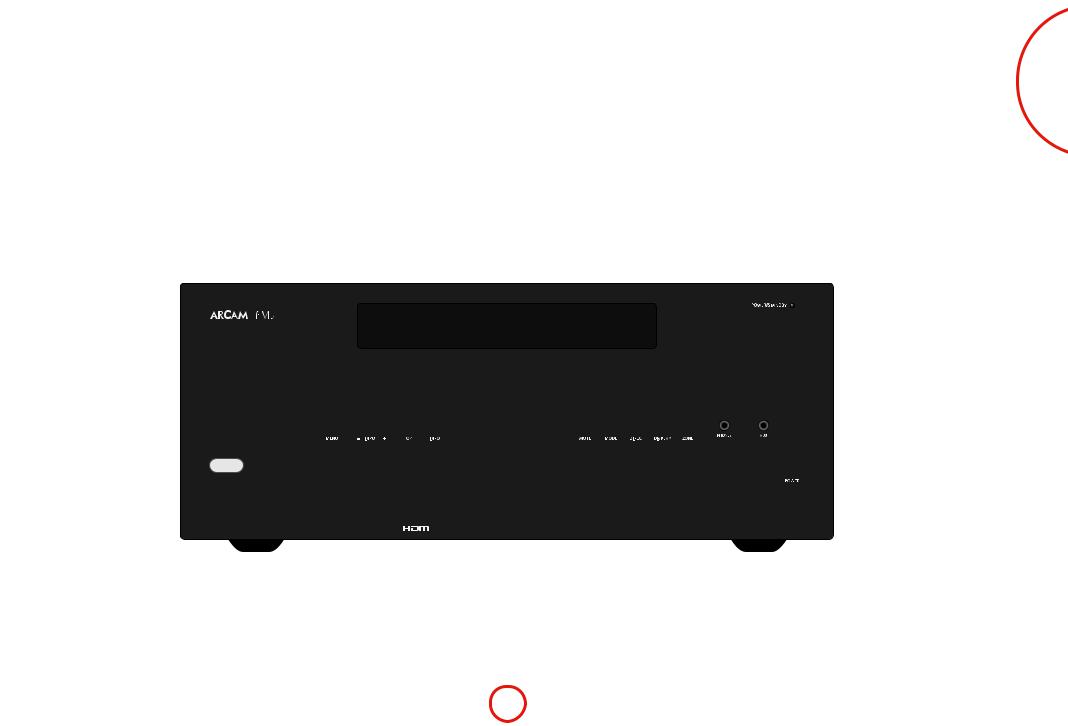
|
|
|
|
|
|
|
|
|
|
|
|
|
|
|
|
|
|
Direct |
|
|
|
|
|
|
|
|
||||||
|
|
|
|
|
|
|
|
|
|
|
|
|
|
|
|
|
|
Stereo Direct on/off. Provides a direct analogue path from |
||||||||||||||
front panel |
|
|
|
|
|
|
|
|
|
|
|
|
|
|
|
|
the analogue inputs to the left and right front outputs. |
|||||||||||||||
|
|
|
|
|
|
|
|
|
|
|
|
|
|
|
|
Switches off any surround processing modes and shuts |
||||||||||||||||
|
|
|
|
|
|
|
|
|
|
|
|
|
|
|
|
down the DSP circuits for best stereo sound quality. |
||||||||||||||||
operation |
|
|
|
|
|
|
|
|
|
|
|
|
|
|
|
|
||||||||||||||||
|
|
|
|
|
|
|
|
|
Mode |
|
|
|
|
|
Display |
|
|
|
|
|
|
|
||||||||||
|
|
|
|
|
|
|
|
|
|
|
|
|
|
|
|
|
|
|
|
|
|
|
||||||||||
|
|
|
|
|
|
|
|
|
|
|
|
|
|
|
|
|
|
|
|
|
|
|
|
|
|
|||||||
|
|
|
|
|
|
|
|
|
|
Selects between Stereo |
|
|
|
|
|
|
|
|
|
|
|
|||||||||||
|
|
|
|
|
|
|
|
|
|
|
|
|
|
|
|
|
|
|
|
|
|
|
|
|
|
|
|
|
||||
|
|
|
|
|
|
|
Info |
|
|
|
|
|
This switches the display brightness |
|||||||||||||||||||
|
|
|
|
|
|
|
and the available surround |
|
|
|
|
|
||||||||||||||||||||
|
|
|
|
|
|
|
|
|
|
|
|
|
|
|
between off/dim/bright. |
|
|
|
|
|
|
|
||||||||||
|
|
Selects the information displayed on the |
modes for the current |
|
|
|
|
|
|
|
|
|
|
|
|
|||||||||||||||||
|
|
|
|
|
|
|
|
|
|
|
|
|
|
|
|
|
|
|
|
|
||||||||||||
|
|
|
lower left portion of the front panel. |
|
source. |
|
|
|
|
|
|
|
Zone |
|
|
|
|
|
|
|
|
|||||||||||
|
|
|
|
|
|
|
OK |
|
|
|
|
|
|
|
|
|
|
|
|
|
|
|
|
|
|
|
||||||
|
|
|
|
|
|
|
|
|
|
|
|
|
|
|
|
|
|
Selects between Zone 1 and |
||||||||||||||
|
|
Used to enter selections made in the |
|
|
|
|
|
|
|
|
|
|
|
|
Zone 2 control. |
|
|
|
|
|
|
|
||||||||||
|
|
|
|
|
Setup menu. |
|
|
|
|
|
|
|
|
|
|
|
|
|
|
|
|
|
|
Power/Standby LED |
|
|||||||
|
|
|
|
|
|
|
|
|
|
|
|
|
|
|
|
|
|
|
|
|
|
|
|
|
|
|
This indicates the status of the receiver and is |
|||||
|
|
|
|
|
|
|
|
|
|
|
|
|
|
|
|
|
|
|
|
|
|
|
|
|
|
|
green when the Receiver is powered on. Red |
|||||
|
|
|
|
|
|
|
|
|
|
|
|
|
|
|
|
|
|
|
|
|
|
|
|
|
|
|
indicates the unit is in Standby mode. |
|||||
|
|
|
|
|
|
|
|
|
|
|
|
|
|
|
|
|
|
|
|
|
|
|
|
|
|
|
|
|
|
|
|
|
|
|
|
|
|
|
|
|
|
|
|
|
|
|
|
|
|
|
|
|
|
|
|
|
|
|
|
|
Phones |
|
|||
|
|
|
|
|
|
|
|
|
|
|
|
|
|
|
|
|
|
|
|
|
|
|
|
|
|
|
|
|||||
|
|
|
|
|
|
|
|
|
|
|
|
|
|
|
|
|
|
|
|
|
|
|
|
|
|
|
|
This socket accepts headphones with |
||||
|
|
|
|
|
|
|
|
|
|
|
|
|
|
|
|
|
|
|
|
|
|
|
|
|
|
|
|
an impedance rating between 32Ω and |
||||
|
|
|
|
|
|
|
|
|
|
|
|
|
|
|
|
|
|
|
|
|
|
|
|
|
|
|
|
600Ω, fitted with a 3.5mm stereo jack |
||||
|
|
|
|
|
|
|
|
|
|
|
|
|
|
|
|
|
|
|
|
|
|
|
|
|
|
|
|
plug. |
||||
Input |
|
|
|
|
|
|
|
|
|
|
|
|
|
|
|
|
|
|
|
|
|
|
|
|
|
|
Aux |
|
||||
|
|
|
|
|
|
|
|
|
|
|
|
|
|
|
|
|
|
|
|
|
|
|
|
|
|
Auxiliary line level input. |
||||||
|
|
|
|
|
|
|
|
|
|
|
|
|
|
|
|
|
|
|
|
|
|
|
|
|
|
|
|
|||||
These buttons select the source |
|
|
|
|
|
|
|
|
|
|
|
|
|
|
|
|
|
|
|
|
|
|
|
|
|
|
||||||
|
|
|
|
|
|
|
|
|
|
|
|
|
|
|
|
|
|
|
|
|
|
|
|
|
|
|
|
|
|
|
||
connected to the corresponding |
|
|
|
|
|
|
|
|
|
|
|
|
|
|
|
|
|
|
|
|
|
|
|
|
|
|
|
|
|
|
|
|
input (or internal input) |
|
|
|
|
|
|
|
|
|
|
|
|
|
|
|
|
|
|
|
|
|
|
|
|
|
|
Power |
|||||
Unused sources can be prevented |
AVR850 |
|
|
|
|
|
|
|
|
|
|
|
|
|
|
|
|
|
|
|
|
|
|
|
||||||||
from being selected in the setup |
|
|
|
|
|
|
|
|
|
|
|
|
|
|
|
|
|
|
|
|
|
|
|
|
|
|
|
|||||
|
|
|
|
|
|
|
|
|
|
|
|
|
|
|
|
|
|
Switches the main power to the |
||||||||||||||
|
|
|
|
|
|
|
|
|
|
|
|
|
|
|
|
|
|
|
|
|
|
|
|
|
|
|||||||
menu by blanking the name in |
|
|
|
|
|
|
|
|
|
|
|
|
|
|
|
|
|
|
|
|
|
|
|
|
|
|
Receiver on and off. |
|||||
MENU > Input Config. |
|
|
|
|
|
|
|
|
|
|
|
|
|
|
|
|
|
|
|
|
|
|
|
|
|
|
Once the unit is switched off, it |
|||||
|
|
|
|
|
|
|
|
|
|
|
|
|
|
|
|
|
|
|
|
|
|
|
|
|
|
|
|
|||||
|
|
|
|
|
|
|
|
|
|
|
|
|
|
|
|
|
|
|
|
|
|
|
|
|
|
|
|
should be left for at least ten seconds |
||||
|
|
|
|
|
|
|
|
|
|
|
|
|
|
Mute |
|
|
|
|
|
|
|
|
|
|
|
before switching on again. |
||||||
|
|
|
|
|
|
|
|
|
|
|
|
|
|
|
|
|
|
|
|
|
|
|
|
|||||||||
|
|
|
|
|
|
|
|
|
|
|
|
|
|
|
|
|
|
|
|
|
|
|
|
|
|
|
|
|
||||
|
|
|
|
|
|
|
|
|
|
|
|
|
|
Mutes all analogue audio outputs in the |
|
|
|
|
|
|
|
|||||||||||
|
|
|
|
|
|
|
|
|
|
|
|
|
|
currently selected zone. |
|
|
|
|
|
|
|
|||||||||||
|
|
|
|
|
|
|
|
|
|
|
Volume |
|
|
|
|
|
|
|
|
|
Remote control receiver. This is positioned behind |
|||||||||||
|
|
|
|
|
|
|
|
|
|
|
Adjusts the analogue output |
|||||||||||||||||||||
|
|
|
|
|
|
|
|
|
|
|
the display window, above the MENU button on the |
|||||||||||||||||||||
|
|
|
|
|
|
|
|
|
|
|
volume in the selected zone |
|||||||||||||||||||||
|
|
|
Menu |
|
|
|
|
|
|
front panel. Ensure the receiver is in a clear line of |
||||||||||||||||||||||
|
|
|
|
|
|
|
|
(line out, speakers and |
||||||||||||||||||||||||
|
|
|
|
|
|
|
|
|
|
|
sight from the remote control for operation. If this is |
|||||||||||||||||||||
|
|
Selects the Setup menus on the |
|
headphones). |
|
|
|
|
|
|
|
|
||||||||||||||||||||
|
|
|
|
|
|
|
|
|
|
|
not possible, use a separate sensor connected to the |
|||||||||||||||||||||
|
|
on-screen display (OSD). |
|
|
|
|
|
|
|
|
|
|
|
|
|
|
|
|
||||||||||||||
|
|
|
|
|
|
|
|
|
|
|
|
|
|
|
|
|
|
Z1 IR input on the rear panel. |
||||||||||||||
|
|
|
|
|
|
|
|
|
|
|
|
|
|
|
|
|
|
|
|
|
|
|
|
|
|
|||||||
|
|
|
|
|
|
|
|
|
|
|
|
|
|
|
|
|
|
|
|
|
|
|
|
|
|
|
|
|
|
|
|
|
E-19
English
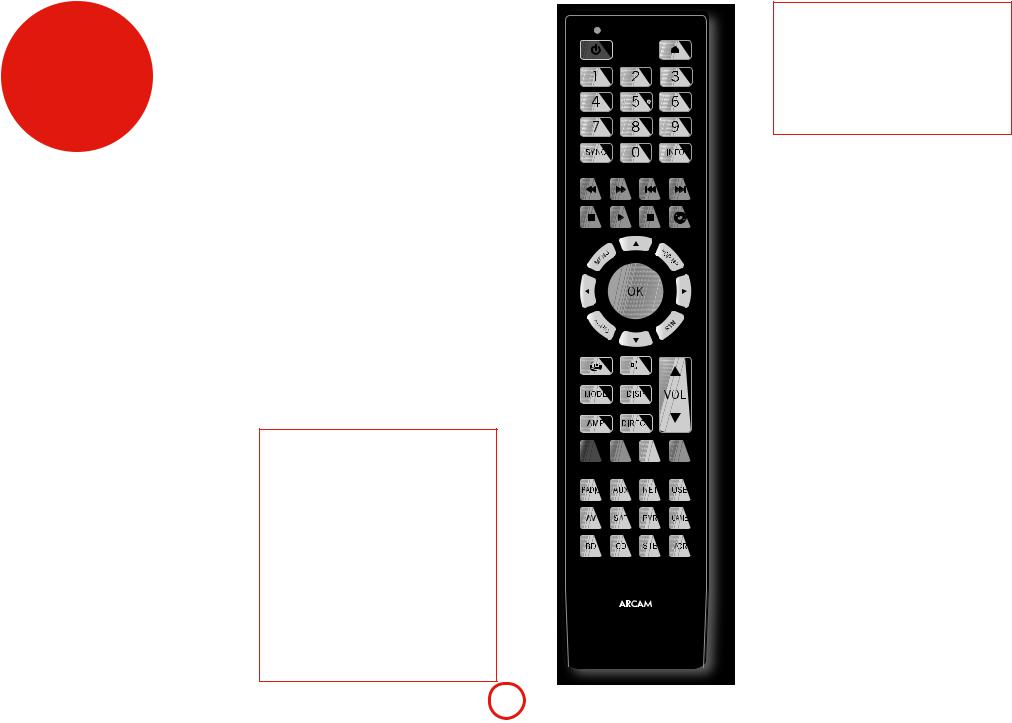
remote control
The universal remote controller
The Receiver is supplied with a sophisticated ‘universal’ backlit remote control that can control up to eight devices. It is pre-programmed for use with the Receiver and many other Arcam products (FM/DAB tuners, CD players and DVD players).
With its extensive built-in library of codes, it can also be used with thousands of third party audio-visual components – TVs, satellite and set-top boxes, PVRs, CD players, etc. See the list of codes at the back of this handbook, beginning on page 47.
It is also a ‘learning’ remote, so you can teach it almost any function from an old single-device remote.
Using the remote control
Please keep in mind the following when using the remote control:
<<Ensure there are no obstacles between the remote control and the remote sensor on the Receiver. The remote has a range of about 7 metres. (If the remote sensor is obscured, the Z1 IR remote control input jack on the rear panel is available. Please consult your dealer for further information.)
<<Remote operation may become unreliable if strong sunlight or fluorescent light is shining on the remote sensor of the Receiver.
<<Replace the batteries when you notice a reduction in the operating range of the remote control.
Inserting batteries into the remote control
1.Open the battery compartment on the back of the handset, by sliding its cover off.
2.Insert two ‘AAA’ batteries, as indicated in the battery compartment.
3.Slide the battery compartment cover back firmly into its locked position with a click.
Notes on batteries:
<<Incorrect use of batteries can result in hazards such as leakage and bursting.
<<Do not mix old and new batteries together.
<<Do not use non-identical batteries together – although they may look similar, different batteries may have different voltages.
<<Ensure the plus (+) and minus (-) ends of each battery match the direction indicated in the battery compartment.
<<Remove batteries from equipment that is not going to be used for a month or more.
<<When disposing of used batteries, please comply with governmental or local regulations that apply in your country or area.
E-20
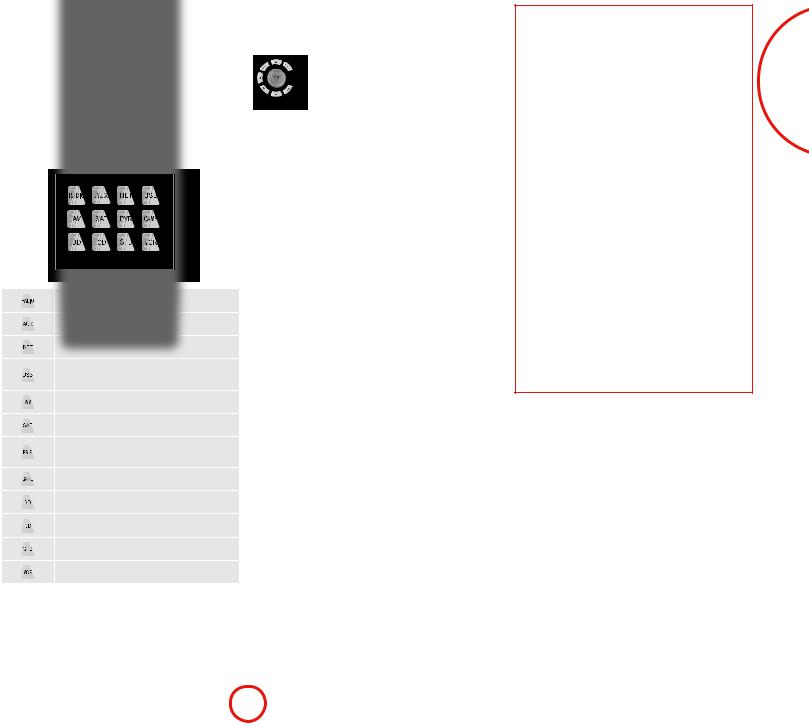
Useful information
Backlight
A backlight comes on for eight seconds whenever a key is pressed. This helps you use the handset in subdued lighting conditions.
LED blinks
Short blinks indicate a valid key press.
Multiple short blinks convey information (such as a device code) or signal the beginning and successful completion of a programming sequence.
The symbol ‘*’ is used in the manual to indicate an LED blink.
Timeouts and unassigned keys
Time out – After 30 seconds the remote exits the programming state and returns to normal operation.
Stuck key timeout – After any key is pressed continuously for 30 seconds, the remote stops sending IR transmission to conserve battery life. The remote remains off until all keys are released.
Unassigned keys – the remote ignores any unassigned key presses for a particular Device Mode and does not transmit IR.
Low voltage indicator
When the batteries are running down, the backlight flashes briefly whenever you press a button.
If this happens, fit two new AAA alkaline batteries as soon as possible.
Device Mode/Source keys
As the remote can control your Receiver as well as a range of other equipment: many of the buttons have more than one function depending on the ‘device mode’ selected on the remote control.
The Device Mode keys (shown below) select the source on the Receiver. If one of these keys is pressed briefly, a command is transmitted to change the source on
the unit. Also the functionality of the remote control changes to operate the selected source device; it’s like having a bundle of different remotes in your hand!
Internal FM or DAB tuner input
Auxiliary input
Ethernet input (e.g. Internet radio)
External USB device (audio files on pen drive, etc.)
Audio-visual sound input (use with TV)
Satellite input
Personal Video Recorder (or Digital
Video Recorder) input
Games console input
Blu-ray Disc or DVD player
Compact Disc player input
Set Top Box decoder input
Video Cassette recorder input
Each Device Mode changes the behaviour of many of the remote keys to control the source device appropriately. For example: in CD mode 9 plays the previous CD track, but in AV mode 9 issues the TV ‘channel down’ command.
The remote remains in the last selected Device Mode so it is not necessary to press a Device Mode key before every command key if all you are doing is playing or skipping tracks on a CD, for example.
 Navigation keys
Navigation keys
The Navigation keys steer the cursor in Setup menus or on-screen menus. They also replicate the navigation functions of original remotes supplied with other home entertainment
devices in your system. OK confirms a setting.
Volume control
By default, the remote is set up so that the volume control and mute buttons always control the volume of the Receiver, regardless of which Device Mode the remote is currently set for. This is known as volume ‘punch through’.
For example, if you are listening to a CD, you will probably have the remote in CD Device Mode to control the CD player. You can use the volume controls on the remote directly to adjust the volume of the Receiver without first having to press AMP to put the remote into AMP Device Mode. The volume buttons ‘punch through’ the CD Device Mode on the remote to the AMP Device Mode.
Volume ‘punch through’ can be disabled individually for any Device Mode if desired.
Customising the remote
The remote offers a Code Learning feature that allows you to copy up to 16 functions from an original remote control onto the remote keypad. For details of this, and other customisation features, see “customising the remote” on page E-38.
The remote complies with Part 15 of the FCC rules
This equipment has been tested and found to comply with the limits for a class B digital device, pursuant to part 15 of the FCC Rules. These limits are designed to provide a reasonable protection against harmful interference in a residential installation. This equipment generates, uses, and can radiated radio frequency energy and if not installed and used in accordance with the instructions,
may cause harmful interference to radio communications. However, there is no guarantee that interference will not occur in a particular installation. If this equipment does cause harmful interference to radio or television reception, which can be determined by turning the equipment off and on, the user is encouraged to try to correct the interference by one or more of the following measures:
Reorient or relocate the receiving antenna.
Increase the separation between the equipment and receiver.
Connect the equipment into an outlet or a circuit different from that to which the receiver is connected.
Consult the dealer or an experienced radio/TV technician for help.
English
E-21
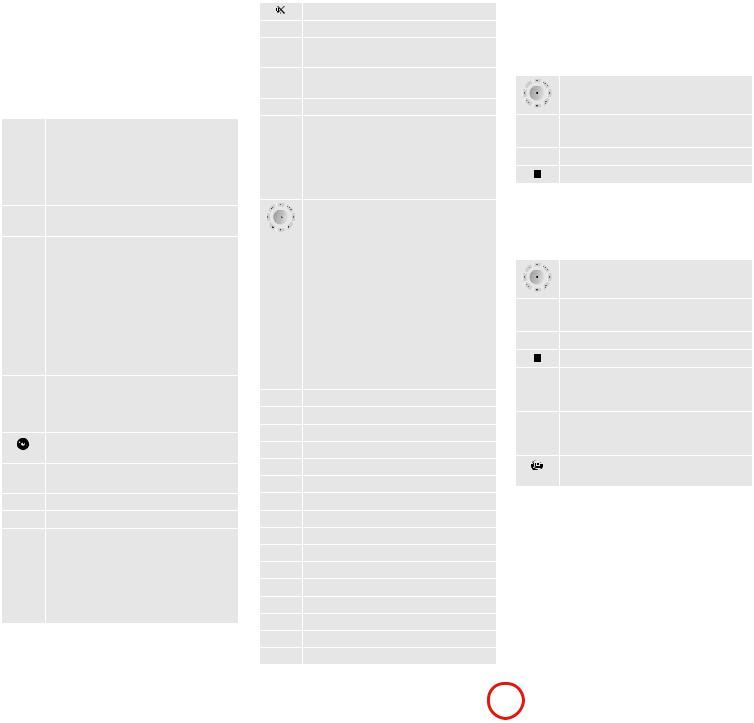
 AMP Device Mode
AMP Device Mode
The AMP Device Mode button configures the remote to control the Receiver. Pressing this button does not affect the currently selected input on the Receiver.
The functionality of the remote is context sensitive for the internal sources and is described in the following table.
2Single press – Toggles Receiver power between standby and on in the current zone (zone in which the command is received).
Press and hold – Forces all zones into standby, regardless of which zone the command was received in.
0......9 |
The number keys can be used for direct |
||||
|
|
|
|
|
|
|
entry of numeric values |
|
|
||
SYNC |
Sync. Delays may be introduced into the |
||||
|
video signal by video processing which |
||||
|
causes a mismatch between the audio and |
||||
|
video timing. You will notice this by speech |
||||
|
sound being out of synchronization with the |
||||
|
lip movements in the video. To compensate |
||||
|
for this, you can adjust the lip sync delay. |
||||
|
Press the SYNC button and use the <and > |
||||
|
navigation buttons. Press again to exit the |
||||
|
lip sync trim menu. |
|
|
|
|
INFO |
Info cycles through the information |
||||
|
|||||
|
displayed on the lower left portion of the |
||||
|
front panel display when on TUN, NET and |
||||
|
USB inputs. |
|
|
|
|
|
Brings up the DTS:X dialogue control |
||||
|
adjustment. |
|
|
|
|
MENU |
Displays the unit’s setup menu on the On |
||||
|
|||||
|
Screen Display. |
|
|
|
|
POP UP |
Toggles Dolby Volume on/off. |
||||
|
|||||
AUDIO |
Toggles Dirac Live EQ on/off. |
||||
|
|||||
RTN |
Brings up a temporary subwoofer trim |
||||
|
control. Use the |
< |
and |
> |
navigation |
|
|
|
|||
|
buttons. Press RTN again to exit the sub trim |
||||
|
control. As this is a temporary adjustment, |
||||
|
the sub trim level is reset to the value set in |
||||
|
the Speaker Levels menu when the unit is |
||||
|
turned off or put into standby. |
||||
|
Toggles the mute function of the AVR. |
VOL |
Adjust amplifier volume. |
|
|
MODE |
Cycles through the available surround and |
|
downmix modes. |
DISP |
Cycles through the front panel display’s |
|
|
|
brightness options |
AMP |
Resets remote to AMP mode. |
DIRECT |
Stereo direct on/off. Provides a direct |
|
analogue path from the analogue inputs to |
|
the left and right front outputs. Switches off |
|
any surround processing modes and shuts |
|
down the DSP circuits for the best stereo |
|
sound quality. |
|
Navigate the files and menus on the screen. |
|
OK selects the highlighted file or enters |
|
the highlighted menu on the screen – |
|
equivalent to ‘Enter’ or ‘Select’ on some |
|
remote controls. |
|
'Up |
|
<Left |
|
> Right |
|
,Down |
|
AMP + 'Power on from standby |
|
AMP + ,Standby from Power on |
|
AMP + OK select Zone 2 |
RED |
Red button. |
|
|
GREEN |
Green button. |
YELLOW |
Yellow button. |
BLUE |
Blue button. |
RADIO |
Tuner input. |
|
|
AUX |
Aux input. |
|
|
NET |
Network (NET) input. |
|
|
USB |
USB input. |
AV |
AV input. |
SAT |
SAT input. |
|
|
PVR |
PVR input. |
|
|
GAME |
Game console input. |
|
|
BD |
BD input. |
CD |
CD input. |
STB |
STB input. |
|
|
VCR |
VCR input. |
|
USB commands
The USB interface is selected by pressing USB in AMP Device Mode on the remote. When connected to a device storing music files connected by USB, the keys below are used to navigating music tracks.
Navigates the files on screen.
OK selects/plays the highlighted file.
9 Selects the previous/next track in the
:current playlist.
4; Pause and playback of the current track.
Stops playback..
Network commands
When using the network client, the keys below are used to navigate music files in AMP Device Mode.
|
Navigates the files on screen. |
|
OK selects/plays the highlighted file. |
9 |
Selects the previous/next track in the |
: |
current playlist. |
4; |
Pause and playback of the current track. |
|
Stops playback.. |
RED |
Adds the currently displayed radio station |
|
|
|
to the favourites list when using the network |
|
client. |
GREEN |
Removes the currently displayed radio |
|
|
|
station to the favourites list when using the |
|
network client. |
|
Returns navigation to the top level of the |
|
network client menus (‘Home’) |
E-22
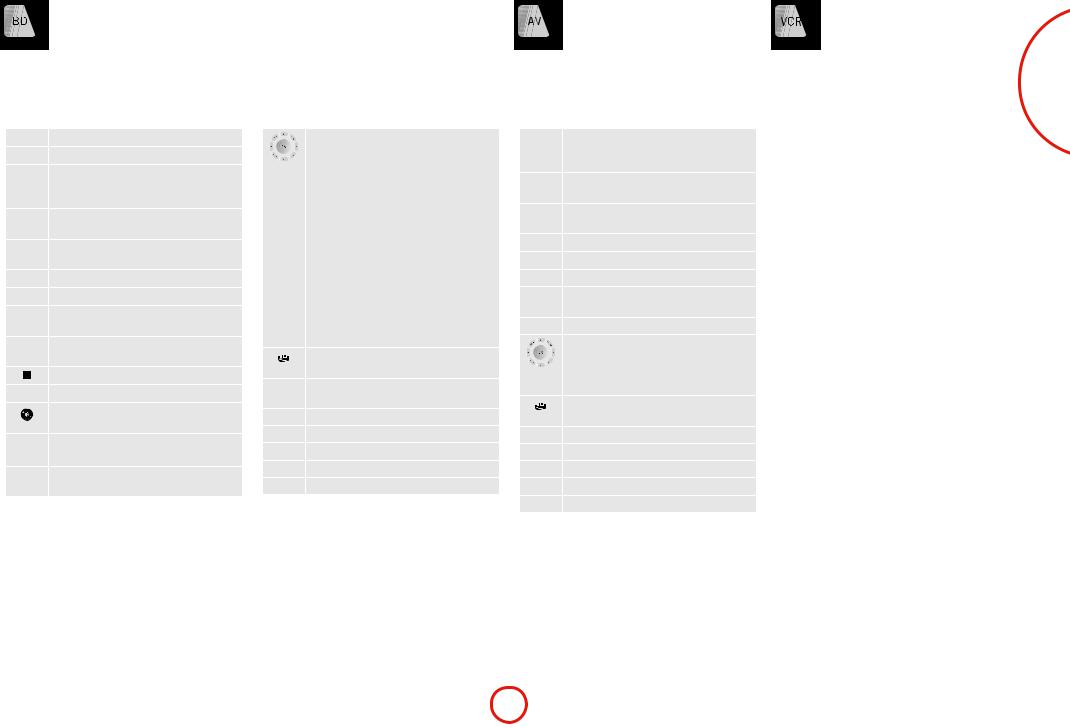
BD/DVD Device Mode
The BD Device Mode button configures the remote to control the functions of Arcam Blu-ray Disc and DVD players, although this can be changed. Pressing this button also selects BD as the source.
2 |
Toggles power between standby and on. |
1 |
Open/close disc tray. |
0...9 |
Searches for and plays the track |
|
|
|
corresponding to the key pressed when |
|
playing a CD. |
DISP |
Cycles through the front panel display’s |
|
|
|
brightness options. |
MODE |
Cycles through the repeat options (track, |
|
disc, etc.). |
7Fast rewind.
8Fast forward.
9Press and release to skip back to the beginning of the current/previous track.
:Press and release to skip forwards to the beginning of the next track.
Stop playback of a BD or DVD.
4; Pause and playback of the current track.
Start recording (on products that have this feature).
MENU Disc menu.
POP UP |
Activates BD/DVD player menu, if |
|
available. |
Navigate setup and BD/DVD programme selection menus.
OK selects the highlighted file or enters the highlighted menu on the screen – equivalent to ‘Enter’ or ‘Select’ on some remote controls.
'Up
<Left
>Right
,Down
BD + 'Power on from Standby BD + ,Standby from Power on
BD + > changes the picture resolution (for BD, only on the Home screen).
|
Returns navigation to the top level of the |
|
menu (‘Home’). |
AUDIO |
Changes audio decode format (Dolby |
|
|
|
Digital, DTS, etc.). |
AMP |
Resets remote to AMP mode. |
|
|
RED |
RED button for BD |
|
|
GREEN |
GREEN button for BD |
YELLOW |
YELLOW button for BD |
BLUE |
BLUE button for BD. |
AV Device Mode
The AV Device Mode button configures the remote to control the functions of a television or other display device. You will need to configure this Device Mode to work with your equipment. Pressing this button also selects AV as the source.
2Toggles power between standby and on. (Some TVs require you to use a number key to turn them on).
0...9 |
Functions as original remote number key – |
|
|
|
usually for channel selection. |
DISP |
Display INFO or OSD (On Screen Display) |
|
function, if available. |
MODE |
AV; this function is TV specific. |
|
|
9 |
Channel down. |
:Channel up.
INFO |
Displays picture information; this function |
|
|
|
is TV specific. |
POP UP |
Guide. |
|
|
|
Navigate setup and programme selection |
|
menus. |
|
OK confirms a selection (equivalent to |
|
‘Enter’ or ‘Select’ on some remotes). |
|
Returns navigation to the top level of the |
|
menu (‘Home’). |
AMP |
Resets remote to AMP mode. |
RED |
RED key for Text TV |
GREEN |
GREEN key for Text TV |
YELLOW |
YELLOW key for Text TV |
|
|
BLUE |
BLUE key for Text TV. |
|
VCR Device Mode
The VCR Device Mode button selects VCR as the source.
The VCR page allows code learning from a dedicated VCR remote – see “customising the remote” on page E-38.
English
E-23
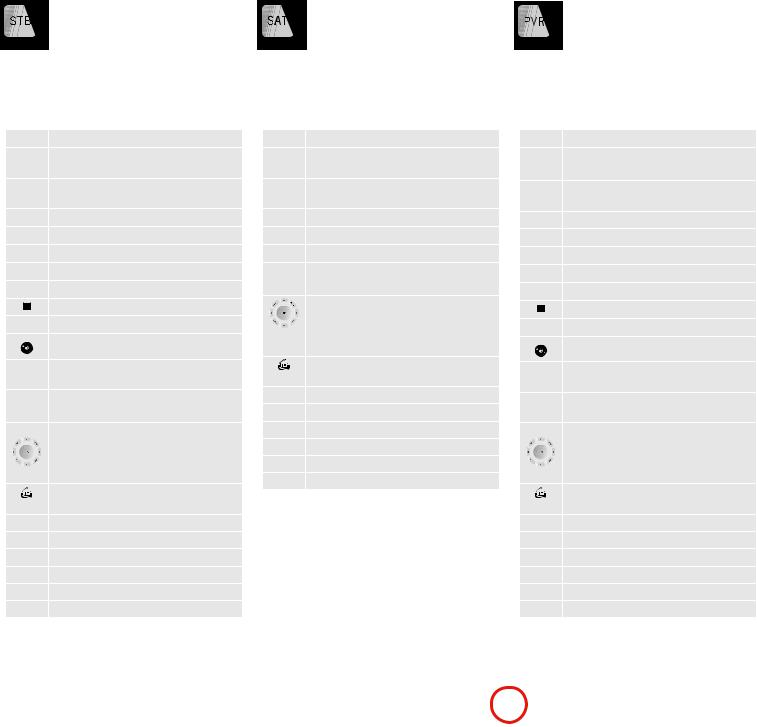
STB Device Mode
The STB Device Mode button selects STB as the source.
If configured to work with your set top box decoder or similar device, the remote can subsequently control the device.
2 |
Toggles power between standby and on. |
0...9 |
Functions as original remote number key – |
|
|
|
usually for channel selection. |
DISP |
Display INFO or OSD (On Screen Display) |
|
function, if available. |
MODE |
Selects the Library or Media function. |
|
7Rewind.
8Fast Forward.
9Channel down.
9Channel up.
|
Stop playback. |
4; |
Pause and playback of the current track. |
|
Record. |
INFO |
Opens the EPG (Electronic Program Guide) |
|
|
|
on some satellite and cable set top boxes. |
POP UP |
Turns on the Menu function if the set top |
|
|
|
box uses this feature. |
|
Navigate setup and programme selection |
|
menus. |
|
OK confirms a selection (equivalent to |
|
‘Enter’ or ‘Select’ on some remotes). |
|
Returns navigation to the top level of the |
|
menu (‘Home’). |
AUDIO |
Selects the Help function. |
AMP |
Resets remote to AMP mode. |
RED |
RED button for set top box. |
|
|
GREEN |
GREEN button for set top box. |
YELLOW |
YELLOW button for set top box. |
BLUE |
BLUE button for set top box. |
|
SAT Device Mode
The SAT Device Mode button selects SAT as the source.
If configured to work with your satellite receiver, the remote can subsequently control the device.
2 |
Toggles power between standby and on. |
0...9 |
Functions as original remote number key – |
|
|
|
usually for channel selection. |
DISP |
Display INFO or OSD (On Screen Display) |
|
function, if available. |
9 |
Channel down. |
9 |
Channel up. |
INFO |
Displays programme information. |
|
|
POP UP |
Guide (or Setup on some set top boxes). |
|
Navigate setup and programme selection |
|
menus. |
|
OK confirms a selection (equivalent to |
|
‘Enter’ or ‘Select’ on some remotes). |
|
Returns navigation to the top level of the |
|
menu (‘Home’). |
RTN |
Back. |
|
|
AMP |
Resets remote to AMP mode. |
|
|
RED |
RED button for Satellite. |
|
|
GREEN |
GREEN button for Satellite. |
YELLOW |
YELLOW button for Satellite. |
BLUE |
BLUE button for Satellite. |
|
PVR Device Mode
The PVR Device Mode button selects PVR as the source.
If configured to work with your personal (hard disc) video recorder or similar device, the remote can subsequently control the device.
2 |
Toggles power between standby and on. |
0...9 |
Functions as original remote number key – |
|
usually for channel selection. |
INFO |
Display INFO or OSD (On Screen Display) |
|
|
|
function, if available. |
MODE |
Selects the Library or Media function. |
7Rewind.
8Fast Forward.
9Channel down. : Channel up.
|
Stop playback. |
4; |
Pause and playback of the current track. |
|
Record. |
MENU |
Opens the EPG (Electronic Program Guide) |
|
|
|
on some satellite and cable set top boxes. |
POP UP |
Turns on the Menu function if the PVR uses |
|
|
|
this feature. |
|
Navigate setup and programme selection |
|
menus. |
|
OK confirms a selection (equivalent to |
|
‘Enter’ or ‘Select’ on some remotes). |
|
Returns navigation to the top level of the |
|
menu (‘Home’). |
AUDIO |
Selects the Help function. |
AMP |
Resets remote to AMP mode. |
|
|
RED |
RED button for PVR. |
|
|
GREEN |
GREEN button for PVR. |
YELLOW |
YELLOW button for PVR. |
BLUE |
BLUE button for PVR. |
|
E-24

CD Device Mode
The CD Device Mode button selects CD as the source.
The button is configured to control the CD functions of Arcam CD players, although this can be changed (see “Locking/Unlocking a specific Device Mode” on page E-39).
2 |
Toggles power between standby and on. |
1 |
Open/close disc tray. |
0...9 |
Searches for and plays the track |
|
|
|
corresponding to the key pressed. |
DISP |
Cycles through the front panel display’s |
|
brightness options. |
MODE |
Cycles through the repeat options (track, |
|
|
|
disc, etc.). |
7Fast rewind.
8Fast forward.
9Press and release to skip back to the beginning of the current/previous track
:Press and release to skip forwards to the beginning of the next track.
Stop playback of a CD
4; Pause and playback of the current track.
POP UP In ‘normal play’ (i.e. the display does not show the letter P), press the 'and , keys to select the track and then MENU stores the track.
In ‘program play’ mode, the MENU key deletes the stored track.
Navigate setup and CD programme selection menus.
OK selects the highlighted file or enters the highlighted menu on the screen – equivalent to ‘Enter’ or ‘Select’ on some remote controls.
'Up
<Left
>Right ,Down
CD + 'Power on from Standby
CD + ,Standby from Power on.
AMP |
Resets remote to AMP mode. |
|
|
RADIO |
Plays the programmed tracks. |
|
English
E-25

essential setup
Before you use your Receiver it is essential that you enter some information into the Setup menus about your speaker configuration. This allows the Receiver to process any surround sound digital source to exactly match your system and give you the ultimate surround sound experience.
There are three pieces of vital information which are outlined in the sections: ‘Speaker Types’, ‘Speaker Distances’ and ‘Speaker Levels’.
The way you enter this information manually into the Receiver is given later in the ‘Setup Menus’ section on page E-28. The settings can also be established automatically using the Arcam Auto Speaker Setup function. However it is important to understand why
these speaker settings must be entered, which is why this section is presented first.
Speaker types
You need to set the type of speakers that you have connected to your Receiver:
Large |
capable of full frequency range reproduction |
Small |
not capable of full frequency range |
|
reproduction at the low frequency end |
None |
speaker not present in your configuration |
The terms ‘Large’ and ‘Small’ do not necessarily relate to the physical size of your speakers. As a rule of thumb, if a speaker cannot reproduce a flat frequency response
down to about 40Hz (and very few can!) it is often better to consider them as ‘Small’ for setup purposes of home cinema.
When a speaker is set to ‘Small’, very low frequency sounds are redirected away from that speaker to a ‘Large’ speaker or a subwoofer, which are far better suited to reproducing these low frequency sounds.
Note that it is not possible to set all speakers to ‘Small’ unless there is a subwoofer in your speaker configuration. If you do not have a subwoofer, you will be forced to set your front speakers to ‘Large’.
(Advanced users may wish to automatically override the ‘Small’ speaker setting for purely stereo music listening when not watching movies. This can be achieved in the ‘Input Config.’ menu – see page E-29.
Crossover frequency
If you have set any speakers as being Small, then you will be required to set a value for the crossover frequency. This is the frequency below which signals are filtered away from these Small speakers and redirected to Large speakers or the subwoofer (if present). A frequency of 80Hz is often a good starting point, however you will probably have to experiment with different values to find the best value for your system or consult your speaker handbook.
Use Channels 6+7 for
If not used in the main zone, it is possible to assign the Surround Back channels to Height 1, bi-amp the Front Left/Right channels or to provide an amplified output to Zone 2.
Speaker Distances
It is essential for the distance from each speaker to the listening position to be accurately measured and entered into the ‘Setup’ menu. This ensures that the sounds from the various speakers arrive at the listening position at the correct time to recreate a realistic surround effect. The distance can be entered in centimetres or inches.
Speaker Levels
Finally the levels of all the speakers in the system need to be adjusted to match each other at the listening position, again to create a proper surround effect. To help with this the Receiver can generate a test noise for each speaker which should be measured with a sound pressure level (SPL) meter. The meter should be set to ‘C’ weighting and slow response. Several smartphone/ tablet apps are available which can also perfom this function. The level of noise measured at the listening position from each speaker should be adjusted on the Speaker Trims page of the Setup menu so that the meter reads 75dB SPL. It does not matter what the system volume setting of the Receiver is before turning the test noise on as the volume setting is over-ridden for the duration of the speaker noise test.
There are several basic SPL meters on the market at reasonable prices aimed at home cinema enthusiasts. Check your local technology store, search online or ask your dealer.
If you do not have an SPL meter or suitable app, you can try to adjust the noise level of each speaker by ear. In this case it is not possible to adjust the speakers to the absolute 75dB SPL volume level, but you should aim for all speakers sounding equally loud. Setting speaker test noise levels by ear is not recommended as it is very difficult to do accurately, but is often better than doing nothing at all!
E-26

auto speaker setup
Dirac Live for Arcam
There is a proprietary automatic loudspeaker setup function built into your Receiver from Dirac Reasearch. Using a PC/MAC based application, this attempts to set all the essential speaker settings for all the speakers in your system. It also calculates room equalisation (Room EQ) filter values to remove some of the worst effects of resonant frequencies in the listening room.
Your Receiver package is supplied with a calibration microphone, which should be inserted into the microphone input of the supplied USB sound card and then into a USB socket on a PC or MAC connected
to the same network as the Receiver and positioned as directed by the Dirac Live for Arcam PC/MAC application. This microphone picks up the special
calibration tones generated by the speakers when Dirac Live for Arcam application is run. The Receiver then analyses the signal and computes:
<<speaker type, <<speaker distance, <<speaker level,
<<problem resonant frequencies in the room which need control by filtering.
To help the system be as accurate as possible when performing Dirac Live for Arcam setup, there are a few guidance rules that should be followed:
<<Minimise any background sounds in the listening room and other nearby rooms.
<<Close all windows and doors in the listening room. <<Turn off all fans including air-conditioning systems. <<Mounting the microphone on a tripod or similar.
<<Position the set up microphone pointing upwards at roughly head height in the normal listening position. It is not necessary to point the microphone directly at the speaker generating the test tone. (It helps if you are able to position the microphone exactly where your head would normally be for listening, with the microphone in direct unobstructed view of all speakers.)
<<If your system includes an active subwoofer, start by setting its output level / gain control to a value roughly matching the front speakers.
When activated, a calibration tone is played through each channel of the Receiver in turn, including the subwoofer channel. The calibration tone cycles round each of the speakers multiple times as the different parameters are calculated. If you do not have a full 7.1 speaker (on the “floor”) configuration there will be periods of silence between some speaker channels. Follow the ‘progress’ information on your PC/MAC.
By default, Room EQ is not applied to any of the source inputs. You should enable Room EQ on inputs you think benefit from this feature, as required, by listening when playing typical source material through each input. After being calculated, this is enabled from within the Input Config menu.
While room equalisation can help to reduce problems with listening room acoustics, it is usually far better to try to solve these problems with the room directly. Proper loudspeaker positioning, acoustic wall
treatments and moving the listening position away from walls should produce far better results overall. However it may be difficult to do this in a home environment, so Room EQ is your next best choice.
Problems
We advise you to look over the reported measurements on the screen following Auto Speaker Setup for any obviously incorrect results, in particular to ensure the reported speakers match your configuration and that the speaker distances to the listening position appear look roughly correct. If the results are not what you expected re-run Auto Speaker Setup.
The Auto Speaker Setup function is normally quite accurate but occasionally false results can be generated. Problems may be as a result of:
<<external sounds or rumbling/handling noises picked up by the microphone
<<sound reflections off hard surfaces (e.g. windows or walls) close to the listening position,
<<very strong acoustic resonances within the room,
<<obstacles (such as a sofa) between speakers and the microphone.
If you are still experiencing difficulties or you wish to have the most accurate results for ultimate surround performance, we recommend using the manual method of establishing speaker distances and levels.
Using subwoofers
If your system includes one or two active subwoofers you may need to set the subwoofer output level/gain control set to a higher or lower value.
Please refer to the Dirac application and quick start guide for full details of how to use the system with your Receiver.
Downloading the Dirac Live for Arcam applcation
To download the Dirac Live for Arcam PC/MAC application and quick start guide, please visit:
www.arcam.co.uk
English
E-27
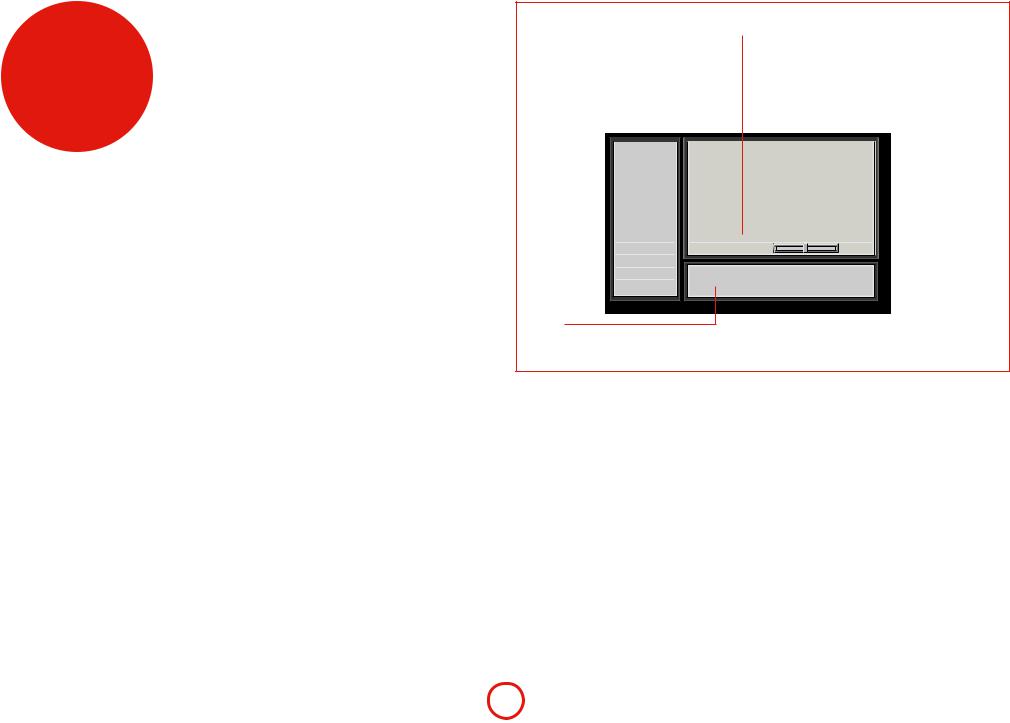
setup menus
The Setup menus allow you to configure all aspects of your Receiver. The next few pages will go through the menu items and explain their function. The Setup
menus will probably look quite daunting if you are new to setting up home cinema, but the majority of them need only be configured once when you first install the system (or if your system changes or you move house!)
The only way to view the Setup menus is on your display device (TV or projector) using the on-screen display (OSD) capability of the Receiver. To view the OSD for the initial setting up, connect any of the video outputs to your display device. You do not need to have a video source connected to the Receiver video inputs.
Entering Setup mode
To enter the setup menu, press the MENU button on the remote control or font panel. The front panel display
shows ‘SETUP MENU’ and the setup menu (pictured right) is displayed.
Menu panel |
|
|
|
|
|
|
Adjustment panel |
|
|
|
|||||||||
The left-hand panel lists the setup |
|
The upper right-hand panel lists the |
|||||||||||||||||
screens available for adjustment. The |
|
parameters you can change as a user. |
|||||||||||||||||
selected menu is highlighted with a grey |
|
The selected line is highlighted with |
|||||||||||||||||
band. |
|
|
|
|
|
a black band. Lines that cannot be |
|||||||||||||
|
|
|
|
|
|
|
|
|
|
|
|
|
|
selected are greyed-out. |
|
|
|||
|
|
|
|
|
|
|
|
|
|
|
|
|
|
|
|
|
|
|
|
|
|
|
|
|
|
|
|
|
|
|
|
|
|
|
|
|
|
|
|
|
|
|
|
|
Input Config |
|
|
|
Source Input |
|
BD |
Scroll bars |
|
||||||
|
|
|
|
|
|
|
|
|
|
|
|
|
|
|
|
|
|||
|
|
|
|
|
General Setup |
|
|
|
|
Incoming format |
|
Dolby Atmos 7.1.4 |
|||||||
|
|
|
|
|
Speaker Types |
|
|
|
|
Incoming sample rate |
192kHz Out: 96kHz |
|
These indicate the |
||||||
|
|
|
|
|
|
|
|
|
|
|
|
|
|
|
|
|
|
|
|
|
|
|
|
|
Speaker Distances |
|
|
|
Incoming bitrate |
Lossless |
position of the |
||||||||
|
|
|
|
|
|
|
|
|
|
|
|
|
|
|
|
|
|
||
|
|
|
|
|
Speaker Levels |
|
|
|
Dialnorm |
-- |
|
|
|
displayed screen |
|||||
|
|
|
|
|
|
|
|
|
|
|
|
|
|
|
|
|
|
||
|
|
|
|
|
|
|
|
|
|
|
|
|
|
|
|
|
|
||
|
|
|
|
|
Video Inputs |
|
|
|
Video Input |
BD |
|
|
within longer menus. |
||||||
|
|
|
|
|
|
|
|
|
|
|
|
|
|
|
|
|
|
||
|
|
|
|
|
HDMI Settings |
|
|
|
Incoming resolution |
1080p50 |
|||||||||
|
|
|
|
|
|
|
|
|
|
||||||||||
|
|
|
|
|
|
|
|
|
|
|
|
|
|
|
|
|
|
|
|
|
|
|
|
|
Mode |
|
|
|
Audio compression |
O |
|
|
|||||||
Zone Settings |
Balance |
0dB |
Network |
|
|
Direct selection of the video input without changing the audio input.
Help screen
The lower right-hand panel gives a short help text for the feature being adjusted.
Navigating the setup menu
… using the remote control
The setup menu can be navigated by using the cursor (arrow) keys on the remote control. This is by far the easiest method.
1.To enter the setup menu, press the MENU button (which is located immediately under the navigation buttons).
2.Use the 'and ,keys to navigate up and down the main section headings in the left-hand panel.
3.Once you have the main section that you require highlighted, use the > key to enter the section.
4.Use the 'and ,keys to navigate up and down the section settings in the right-hand panel. Some settings may be greyed out. These are either for information only (e.g. incoming sampling frequency)
or are not currently selectable (e.g. network IP address when DHCP is used). Scroll bars on the sides of the right hand panel indicate your position in the settings list where there are more items than can be displayed at once.
5.Pressing OK selects a setting to change it, pressing OK again de-selects the setting.
6.At any time, press the MENU button to exit the menu. Any changes to settings are saved.
… using the keys on the front panel
The Receiver front panel controls can be used to configure the unit. Follow the instructions for using the remote control, in this case using INPUT– for down, INPUT+ for up, INFO for left and MODE for right.
E-28
